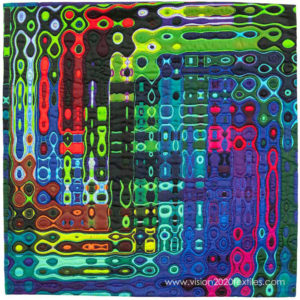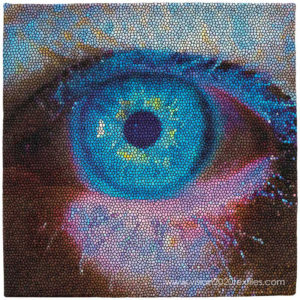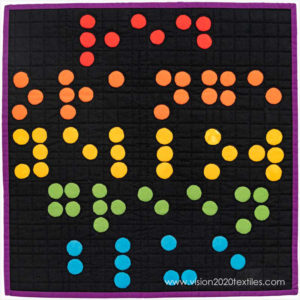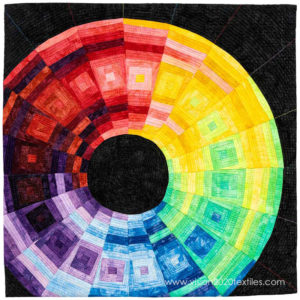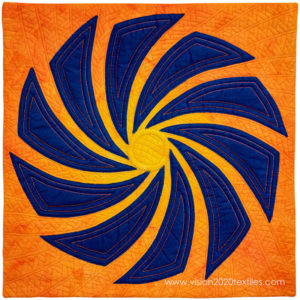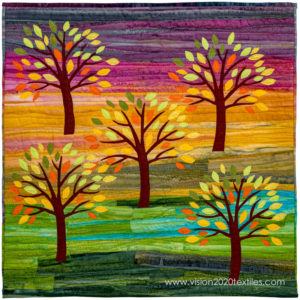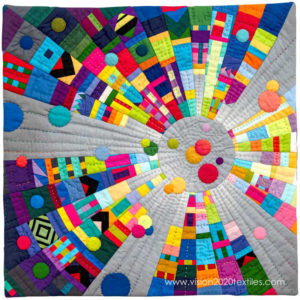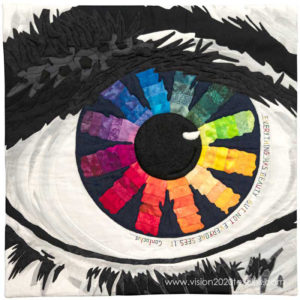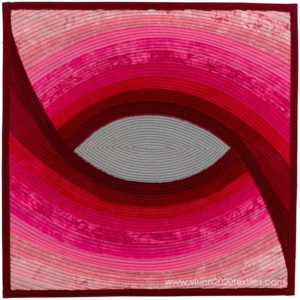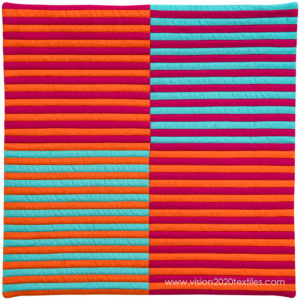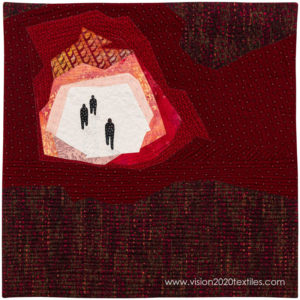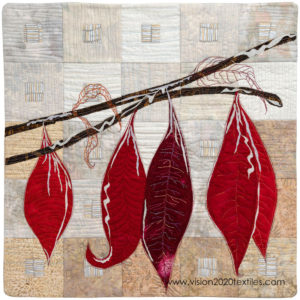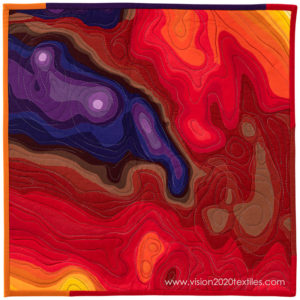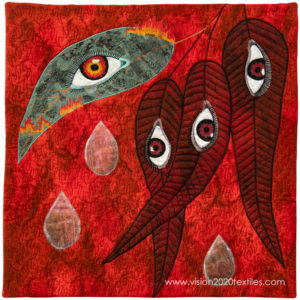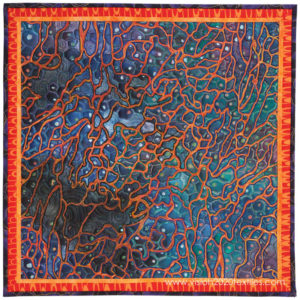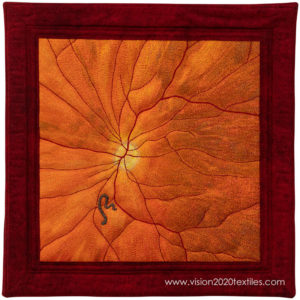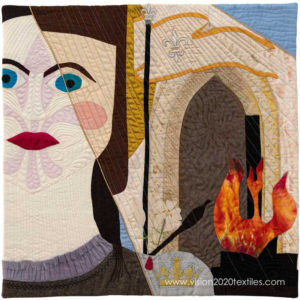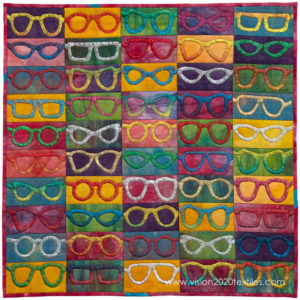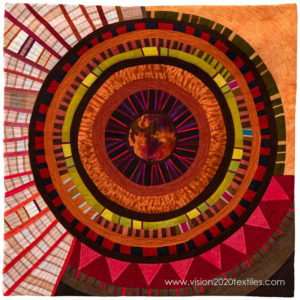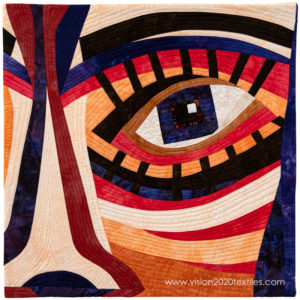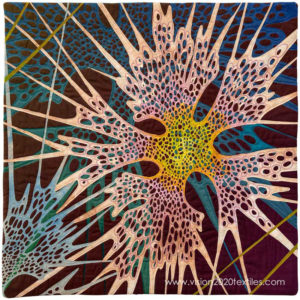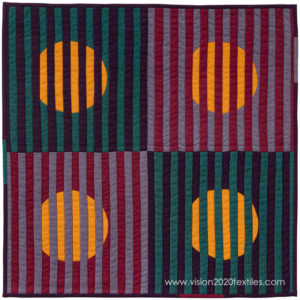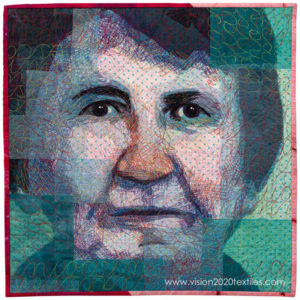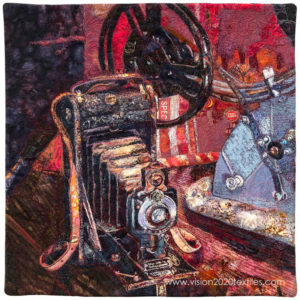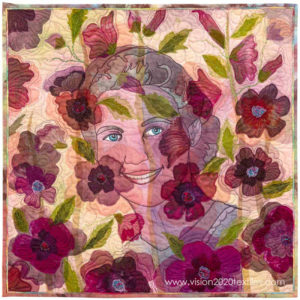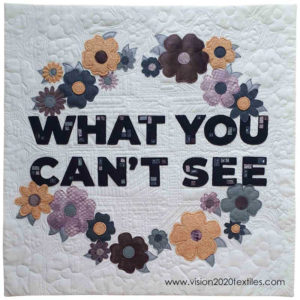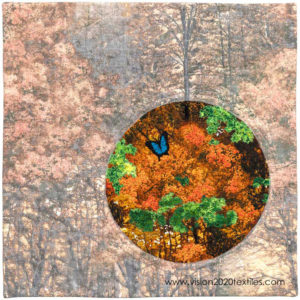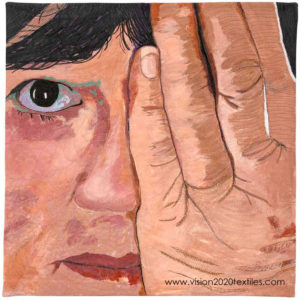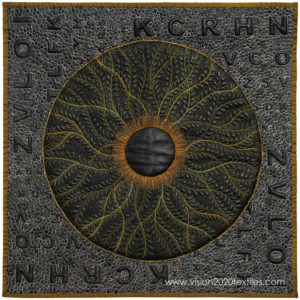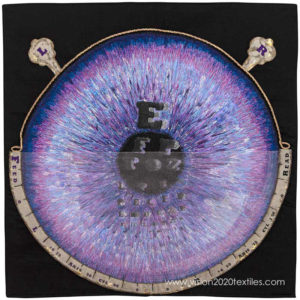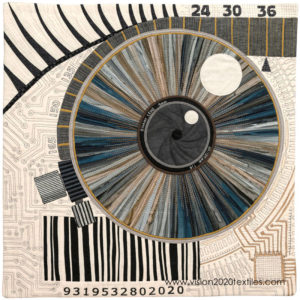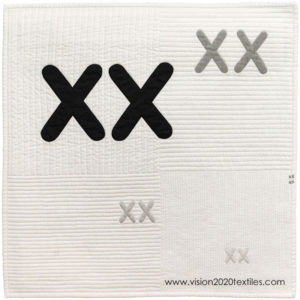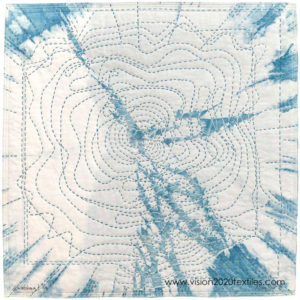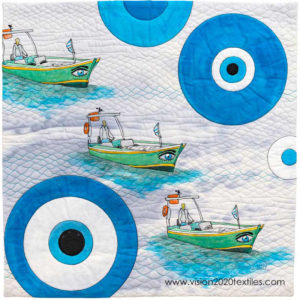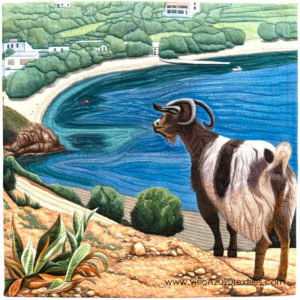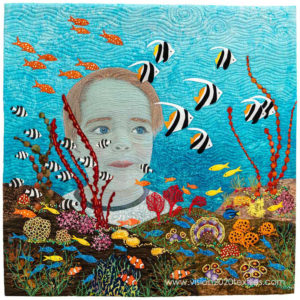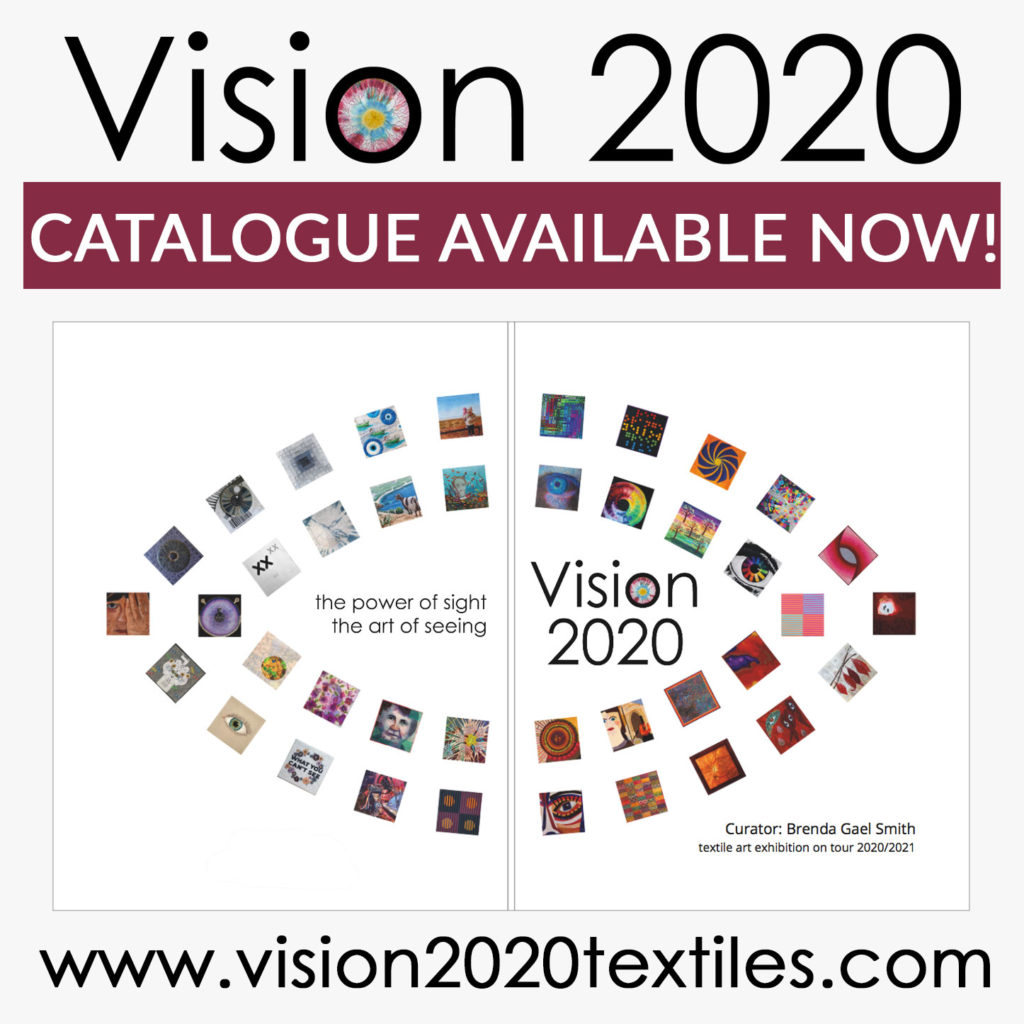All artwork is 20x20in (50x50cm). Purchase a printed Vision 2020 catalogue. Photography by Les Harvey.
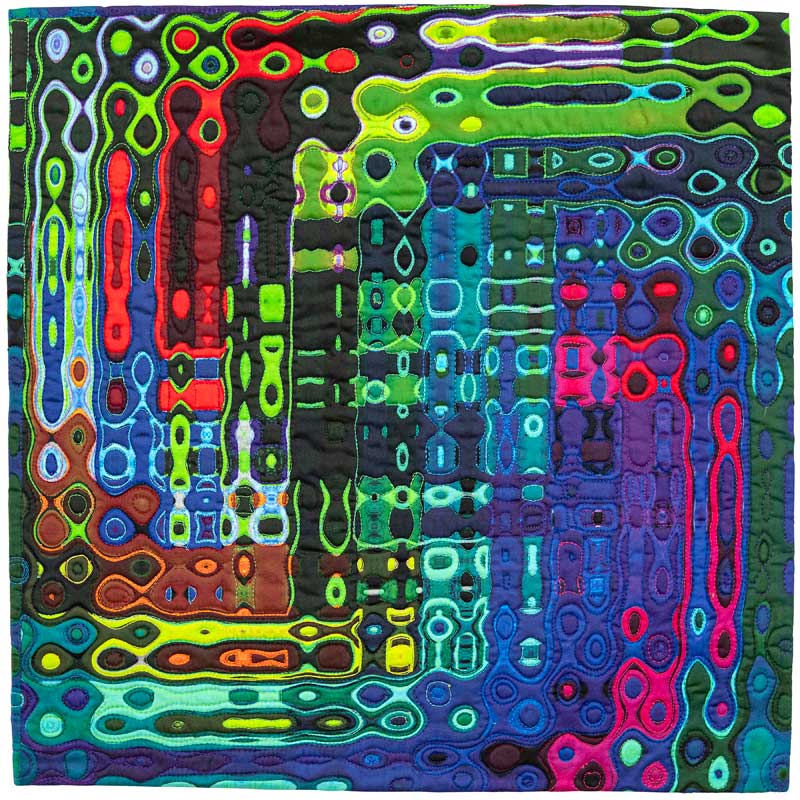
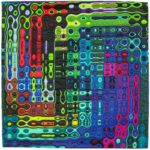
Statement: The fascinating, almost incomprehensible, quantum world is invisible to human eyes. But scientists can 'see' it and prove it via computers, mathematics and experiments. As an artist, I feel free to use my imagination to envision its shapes and colours.
Techniques: Designed in my iPad, commercially printed on fabric, layered and machine stitched.
Materials: Commercially printed cotton of artist's original design, polyester threads.
ENVISIONING THE INVISIBLE:
QUANTUM WORLD
©2020 Alicia Merrett
Wells, Somerset, UK
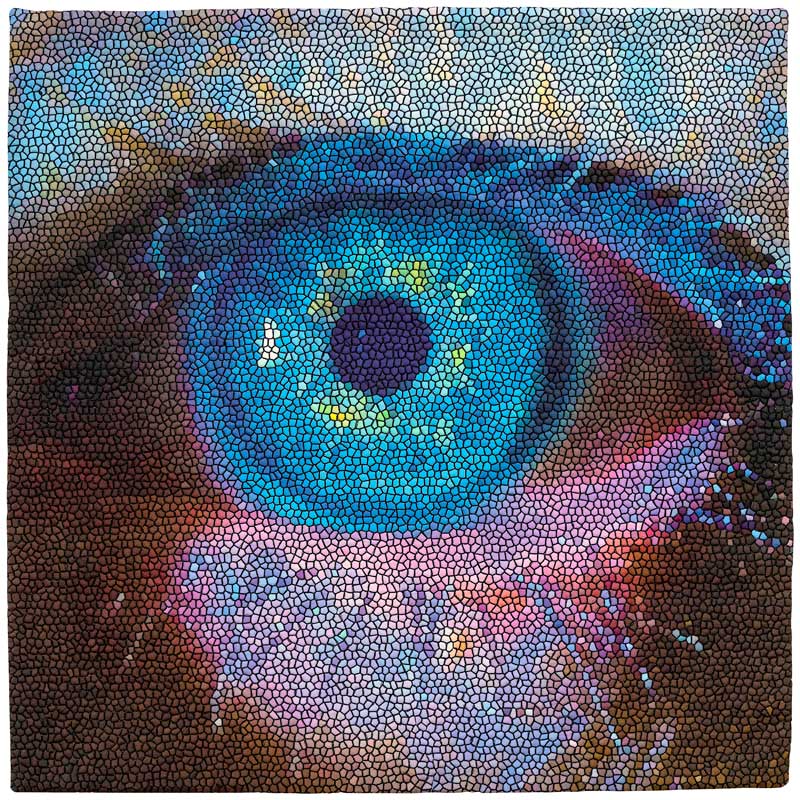
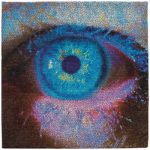
Statement: This 50 year old eye, mine, looks forward with the knowledge of all that I have experienced, good and bad. My vision for 2020 is to BE. Be kinder to myself and others; be more forgiving, tolerant and patient; be better.
Techniques: Whole cloth with dense free machine quilting on domestic machine.
Materials: Digitally printed cotton, cotton and wool batting, cotton backing and thread.
I LOOK WITHIN, TO SEE
©2020 Paula Rafferty
Killonan, Ballysimon, Ireland
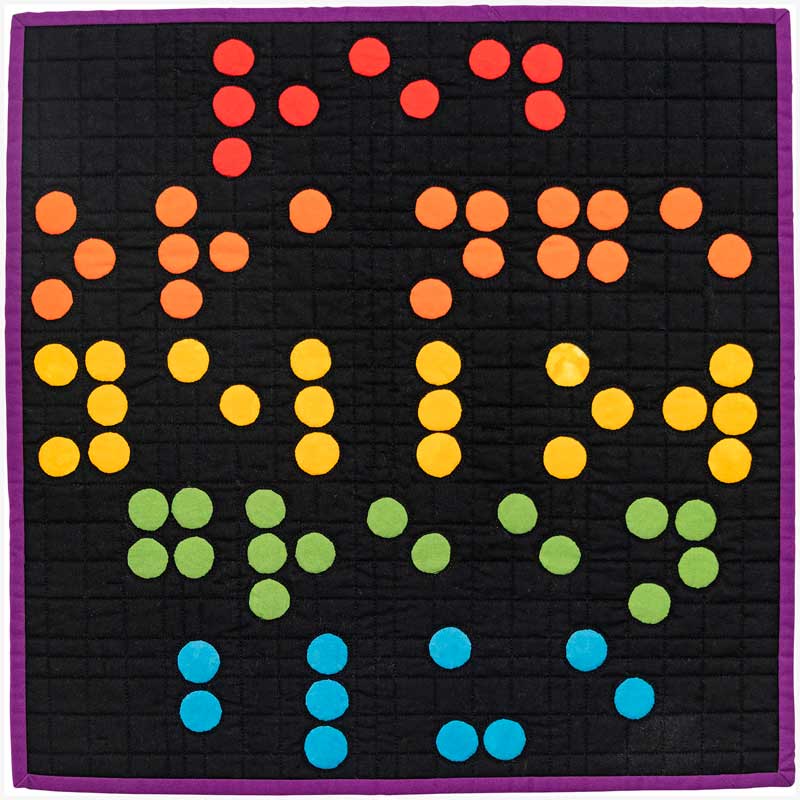
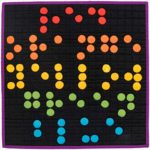
Statement: How do you describe colour to a blind person? What happens if you can't see the whole rainbow of colours? Touching an item is the only way some people can 'see' it. I am feeling privileged to have good vision to be able to see and enjoy colour.
Techniques: Hand appliqué braille letters. Machine quilting.
Materials: Cotton fabric and wool wadding.
TOUCH THE COLOUR
©2020 Jane Rundle
Wakerley, Queensland, Australia
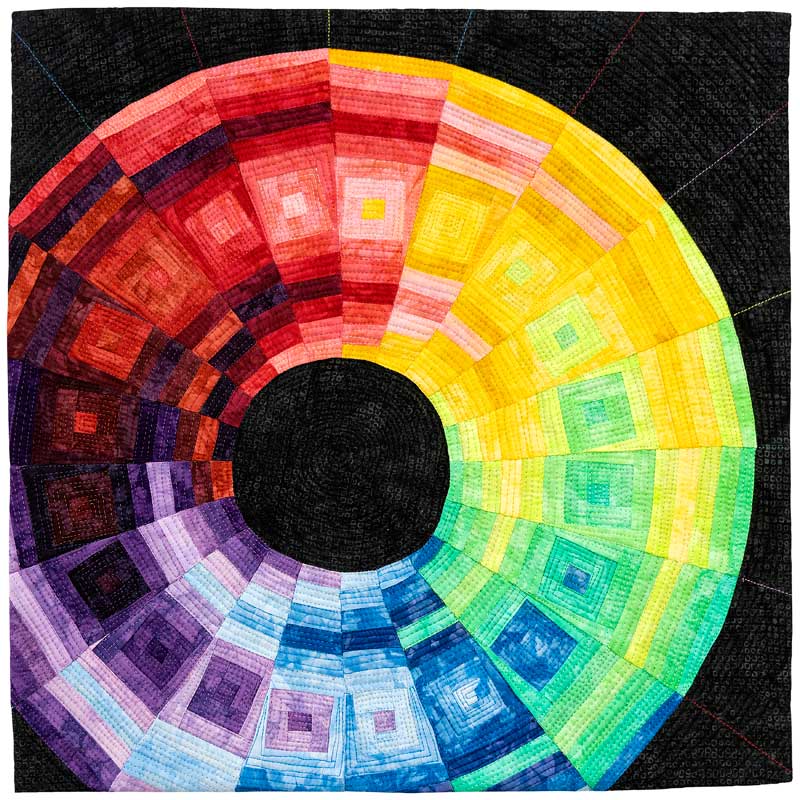
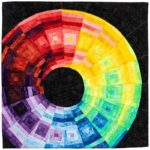
Statement: The iris is a thin, circular structure in the eye, responsible for controlling the amount of light reaching the retina. The iris is also the structure that provides an individual with eye colour. I want the iris to be as colourful as rainbow!
Techniques: Machine piecing and machine quilting.
Materials: Hand dyed and commercial cotton fabrics.
COLOURFUL IRIS
©2020 Maryte Collard
Siauliai, Lithuania
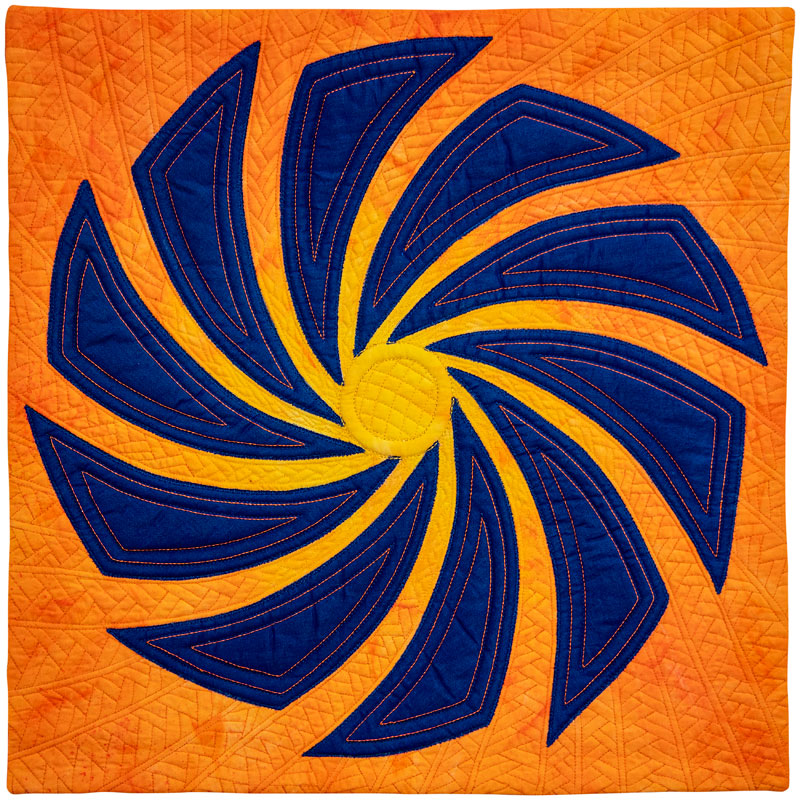
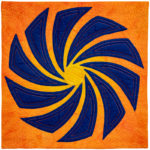
Statement: Seeing things out of focus or blurred is not ideal. Yet, in photography, the shutter speed can be changed to deliberately blur an image, introducing movement as in panned photos.
Techniques: Painted background, raw edge appliqué, trapunto, and machine quilting.
Materials: Cotton, textile paint, cotton and metallic threads.
SHUTTER VISION
©2020 Helen Beaven
Wellington, New Zealand
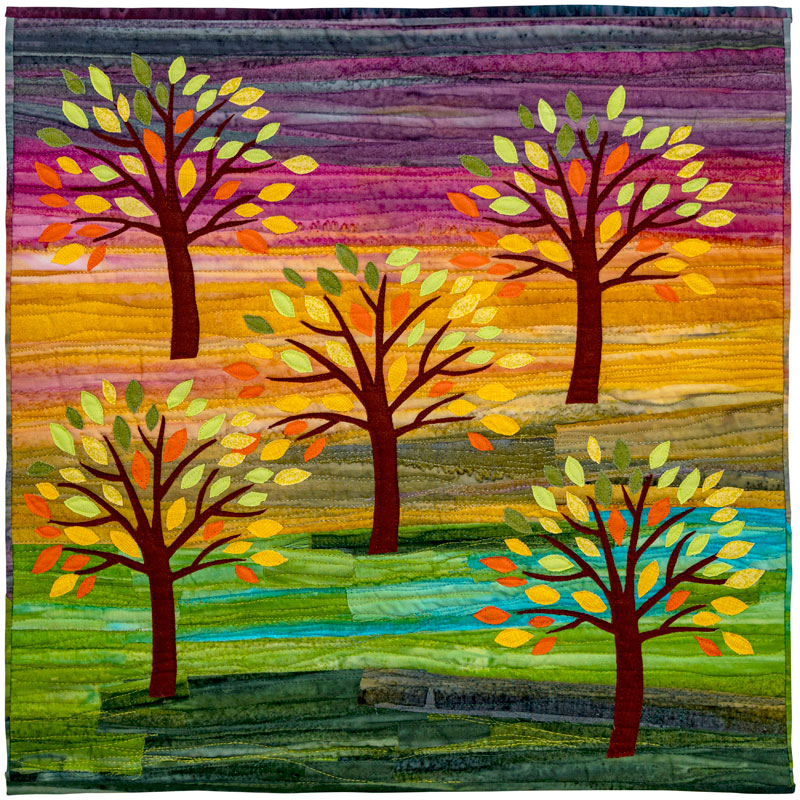

Statement: Background colour can change how we perceive other colours. What we see in not necessarily what is there. There are some small changes to leaf placement also. See if you can spot the differences.
Techniques: Appliqué and free motion quilting.
Materials: Commercial cottons and synthetic batting.
SPOT THE DIFFERENCE
©2020 Mary McArdle
Ivanhoe, Victoria, Australia
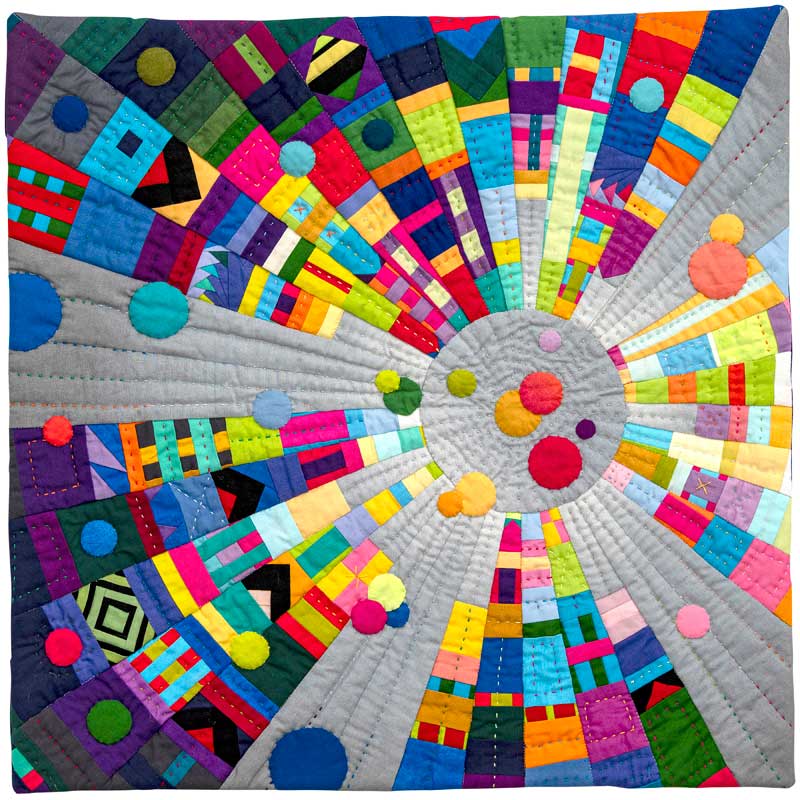
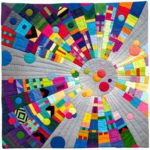
Statement: Will my optimistic dream of a brighter future turn out to be 2020 vision, or just a fun and fabulous fabric fusion of my favourite colours?
Techniques: Machine piecing, hand appliqué, and big stitch hand quilting.
Materials: Cotton and perle 8 thread.
THE FUCHSIA's LOOKING BRIGHT
©2020 Di Jobbins
Zetland, NSW, Australia
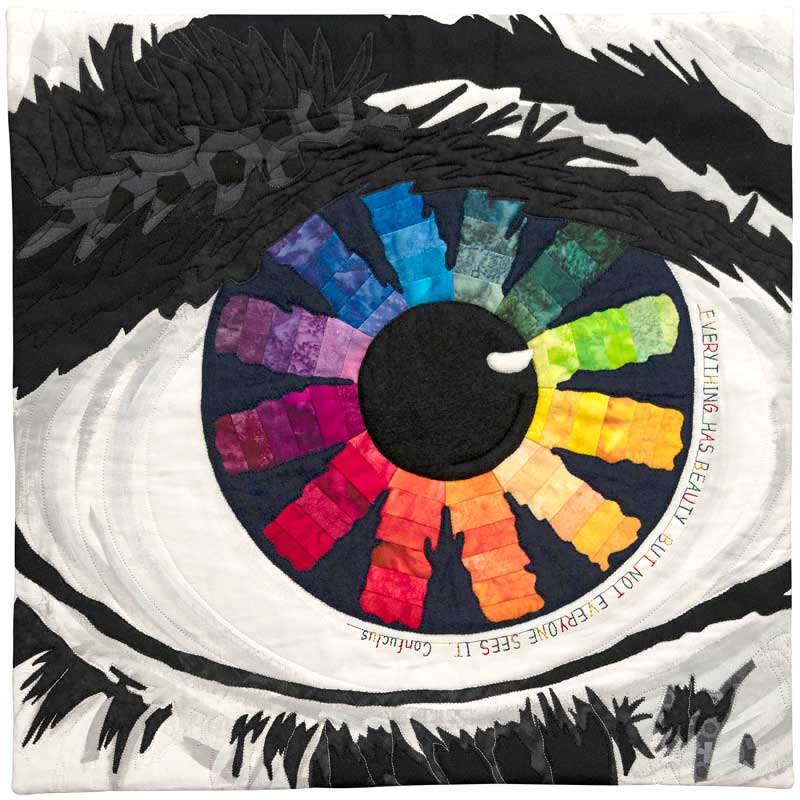
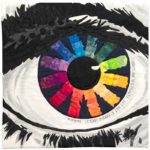
Statement: Our eyes are incredible organs. We view the world in technicolour — but do we really see or acknowledge the beauty of what is in front of our eyes?.
Techniques: Pieced colour wheel appliquéd onto painted background with further appliqué. Machine quilting.
Materials: Cotton fabrics, acrylic paints and wool felt.
EYE OF THE BEHOLDER
©2020 Mary Metcalf
Auckland, New Zealand
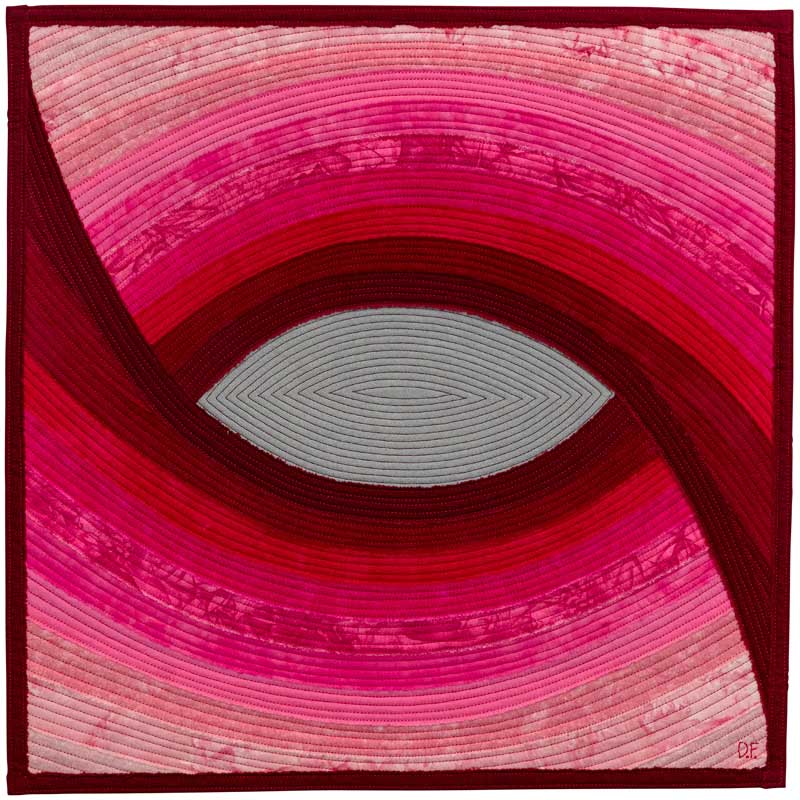
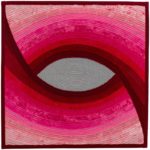
Statement: TCataracts turn the transparent lens in the eye into an opaque grey material that restricts vision. Colours fade and images blur. In first-world countries, a simple medical procedure can replace the lens and restore sight.
Techniques: Torn strip appliqué and machine quilting.
Materials: Viscose felt, cotton, and polyester thread.
CATARACT
©2020 Dianne Firth
Canberra, ACT, Australia
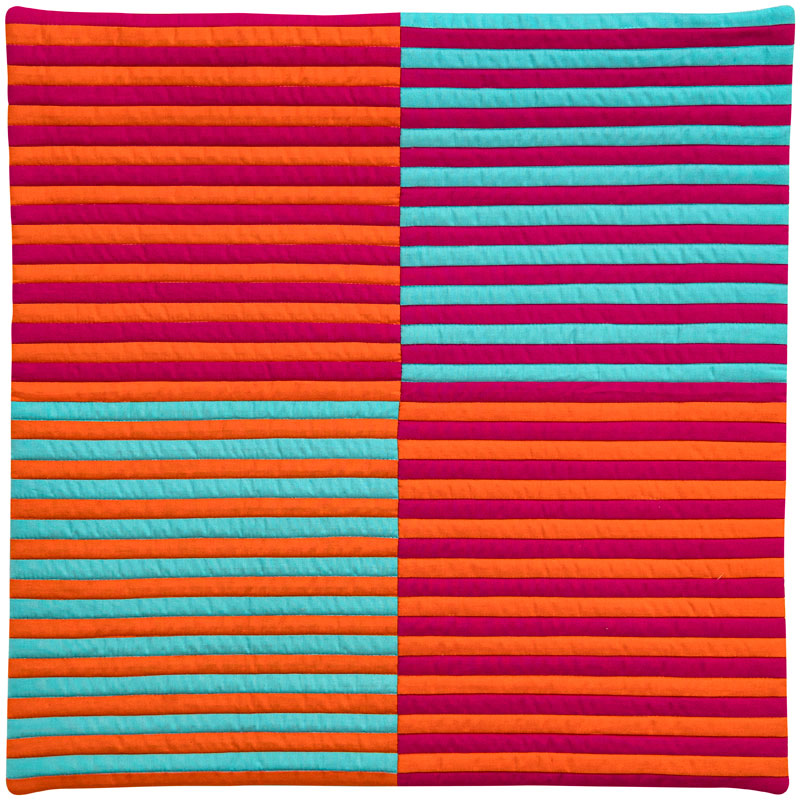
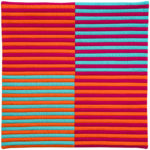
Statement: Lateral Inhibition is the process in which the neurons in the brain and eye work together to see contrast. This is how some optical illusions are created. It intrigues me that a colour, here turquoise, can appear to change depending on its neighbours.
Techniques: Foundation paper piecing, straight line quilting.
Materials: 100% cotton fabrics, wool/poly wadding and monofilament thread.
LATERAL INHIBITION
©2020 Kim Simpson
Kyabram, Victoria, Australia
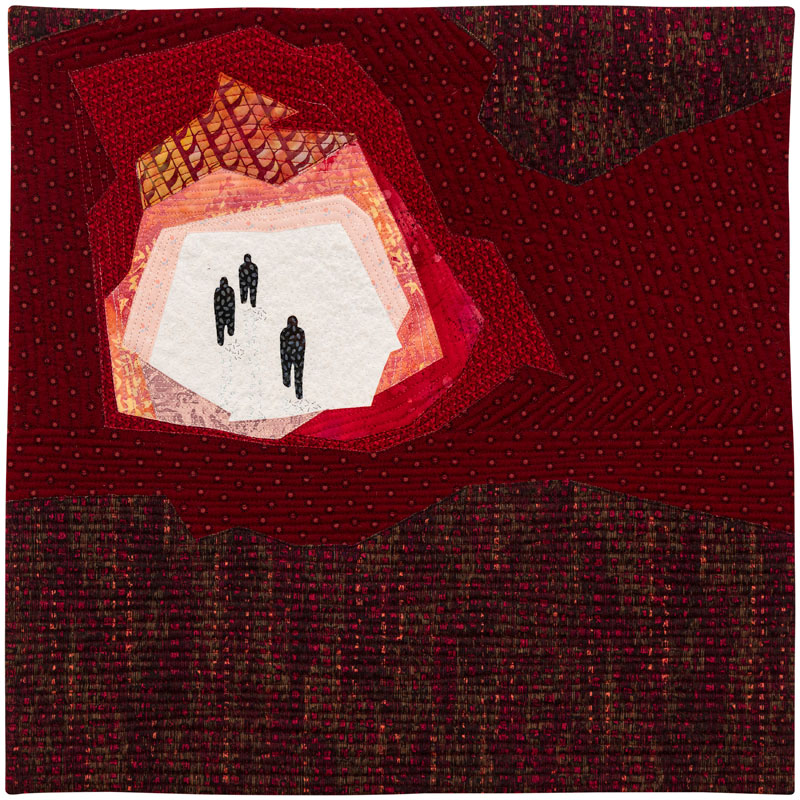
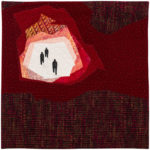
Statement: I create textile art inspired by my surroundings: the street where I live, my home town and the coastline where it is situated. This quilt tells a story about going to work through snowfall.
Techniques: Raw edge appliqué. Machine and hand quilting.
Materials: Cotton fabric, cotton batting, cotton and viscose thread.
TUNNEL VISION IN WINTERTIME
©2020 Anita Fors
Wells, Somerset, UK
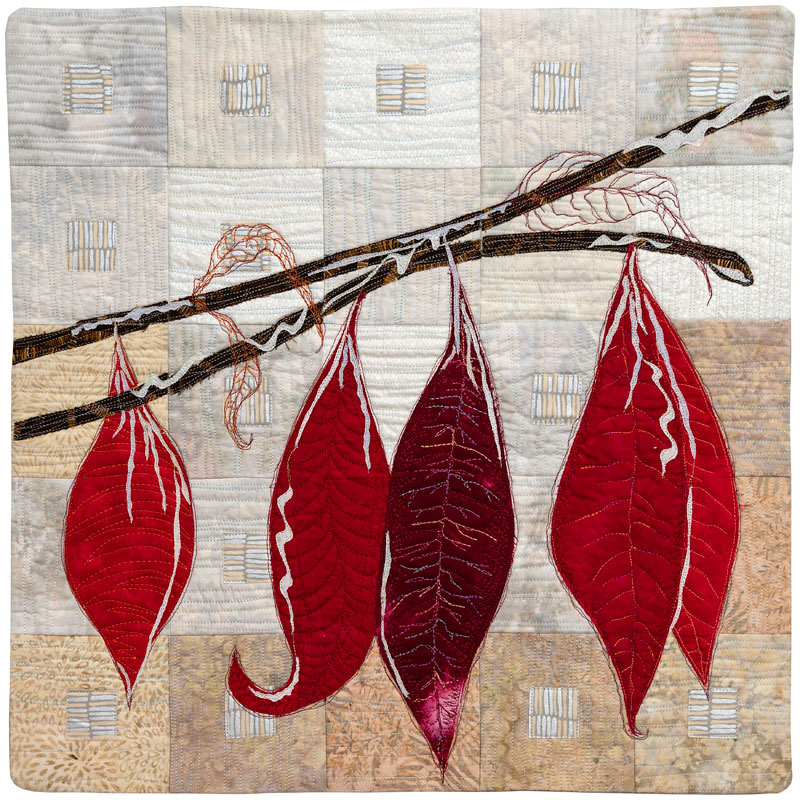

Statement: Red leaves with snow on their branches are stunning in winter! This piece captures the stark contrasts of the winter months.
Techniques: Appliqué and thread drawing.
Materials: Commercial and hand-dyed cotton fabric.
SNOW ON RED LEAVES
©2020 Cindy Loos
Columbia, South Carolina, USA
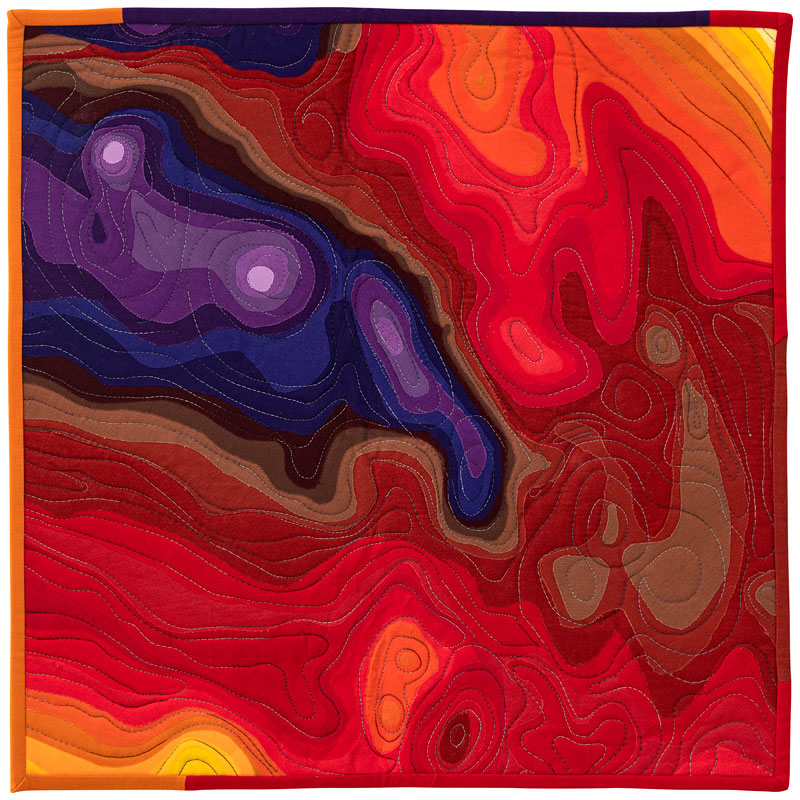
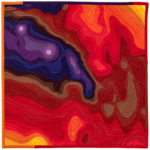
Statement: Hottest October on record! Bush fire warning! Fast forward a month and we have the worst bush fires in history. Having foresight, or vision, of what was to come, would we have changed anything? Will we ever have the vision to take climate change seriously?
Techniques: Appliqué. Free motion stitching.
Materials: Commercially dyed fabrics.
EYE OF THE 'HEAT' STORM
©2020 Brenda Wood
Ascot, Queensland, Australia
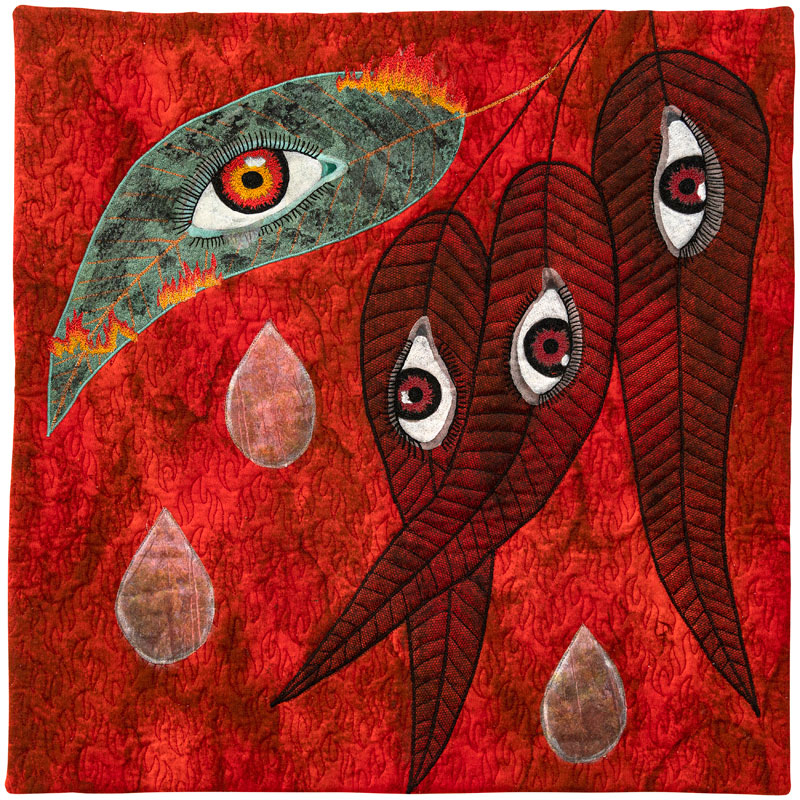
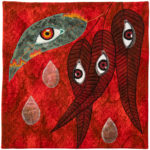
Statement: The eucalyptus leaf weeps for the trees destroyed during another year of bush fires, but the Australian bush is resilient and after each fire the trees and undergrowth gradually recover.
Techniques: Appliqué, photo imagery, and machine embroidery.
Materials: Cotton, tulle, fabric paint and embroidery threads.
THE EYE OF THE BEHOLDERS
©2020 Sue Reid
Kyabram, Victoria, Australia
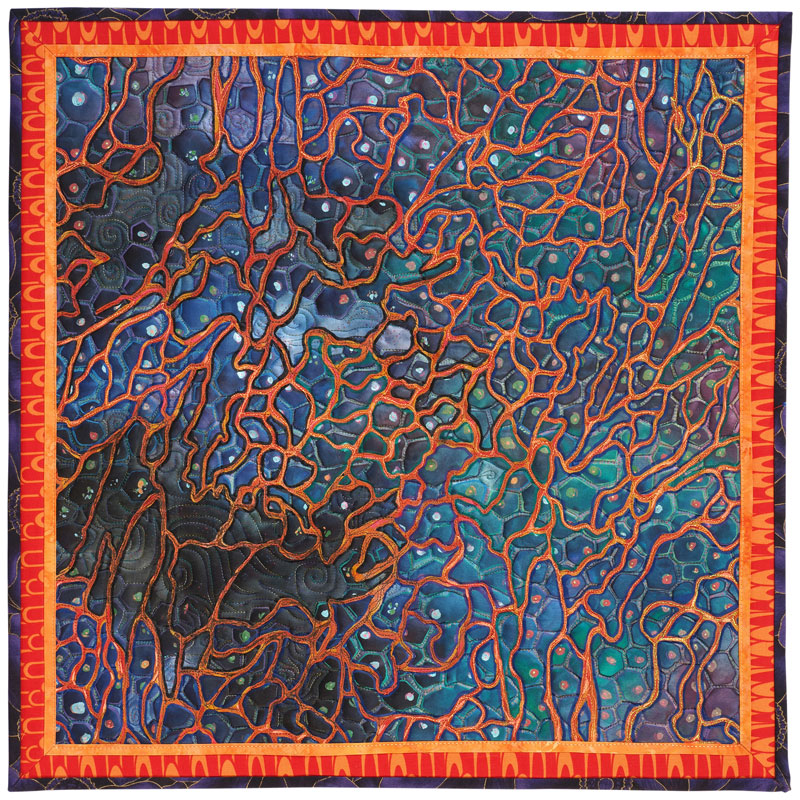

Statement: We study age-related macular degeneration which begins with death of the retinal pigment epithelium and choriocapillaris (shown), without which the retina cannot survive. Understanding cellular mechanisms of this blinding disease is a key goal.
Techniques: Painting, printing, appliqué and free motion quilting.
Materials: Paint, silk, non-wovens, polyester thread and cotton.
RPE3: AGE-RELATED MACULAR DEGENERATION
©2020 Shannon Conley
Moore, Oklahoma, USA
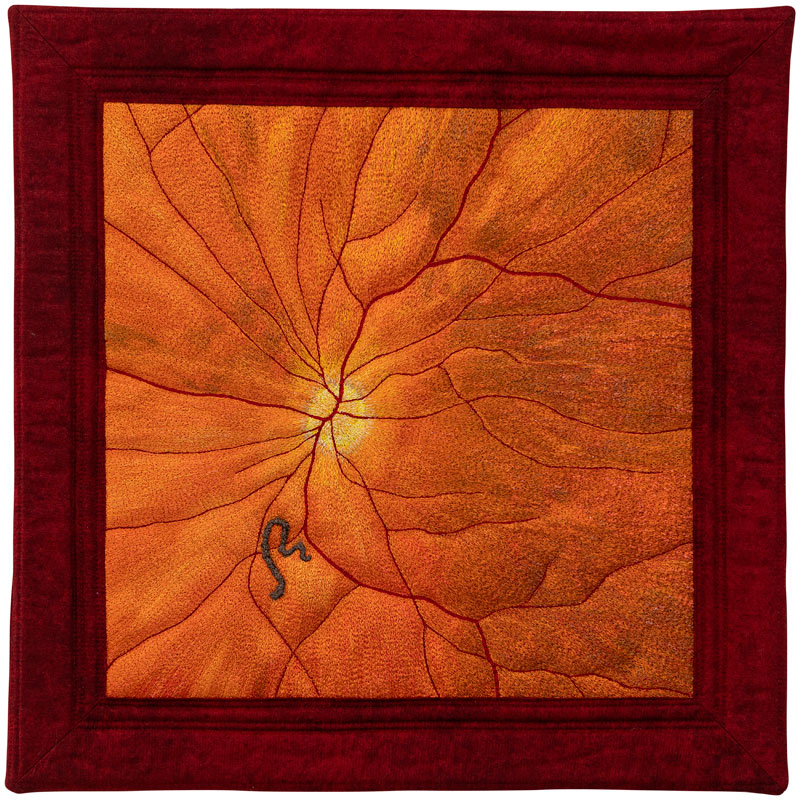
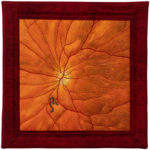
Statement: This piece is a thread painted impression of a fundus photo of my retina, which shows the very large floater I have developed in my eye. The floater looks like a piece of thread in my vision, which I think is quite fitting for a textile artist!
Techniques: Thread painted with free motion embroidery and trapunto quilted.
Materials: Machine embroidery thread on cotton and a lot of stabiliser.
THE FLOATER
©2020 Victoria Mansfield
Alexandra Hills, Queensland, Australia
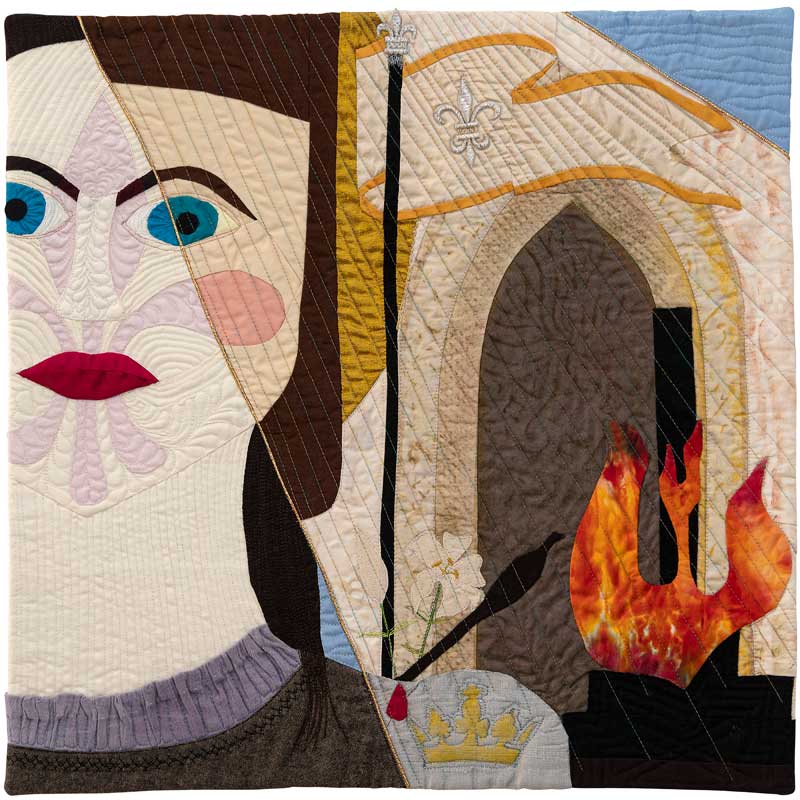
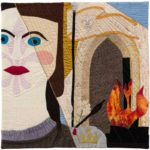
Statement: The rich iconography and discordant uses to which Joan's story has been appropriated makes her legacy fascinating and problematic in equal measure. I hoped to capture the overburdened legend of her vision of her own wondrous and horrific short life.
Techniques: Piecing, needle-turn and fused appliqué, couching, gathering, and machine embroidery.
Materials: Hand dyed and commercial broadcloth and sateens, silk, gauze, linen, rayon, paint stick and gold cord.
THE VISION OF ST JOAN
©2020 Monica Johnstone
Grand Rapids, Michigan, USA
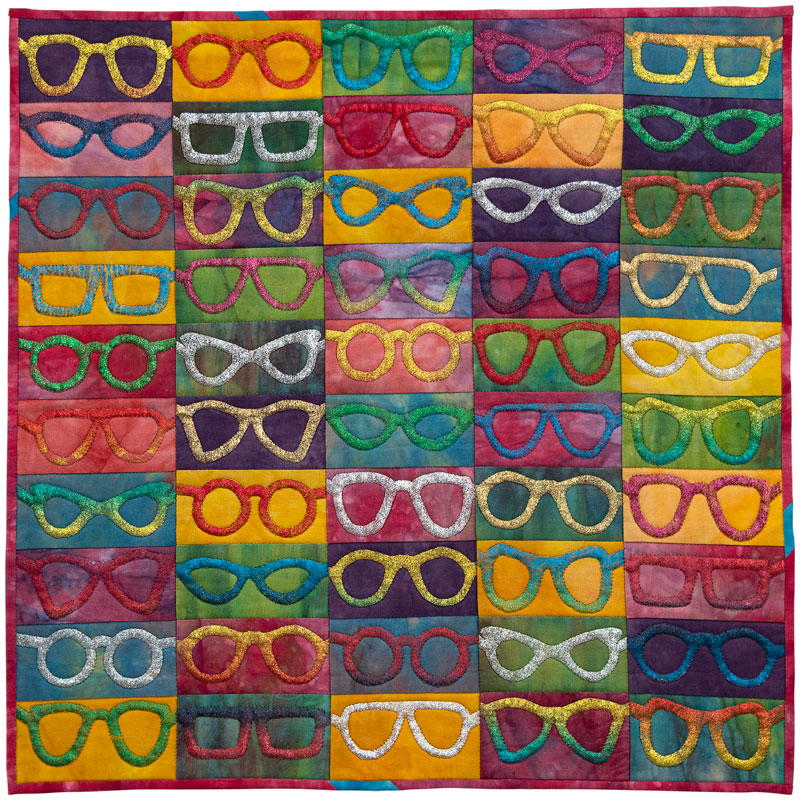
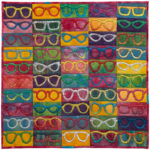
Statement: When life gets out of focus, many of us have to visit the optometrist, resulting in the need for new spectacles. Living in a first world country, we are lucky to have a vast selection of suitable and stylish spectacles.
Techniques: Foiling and machine quilting.
Materials: Cotton, foils and threads.
I CAN SEE CLEARLY NO
©2020 Sheila Beer
Matraville, NSW, Australia
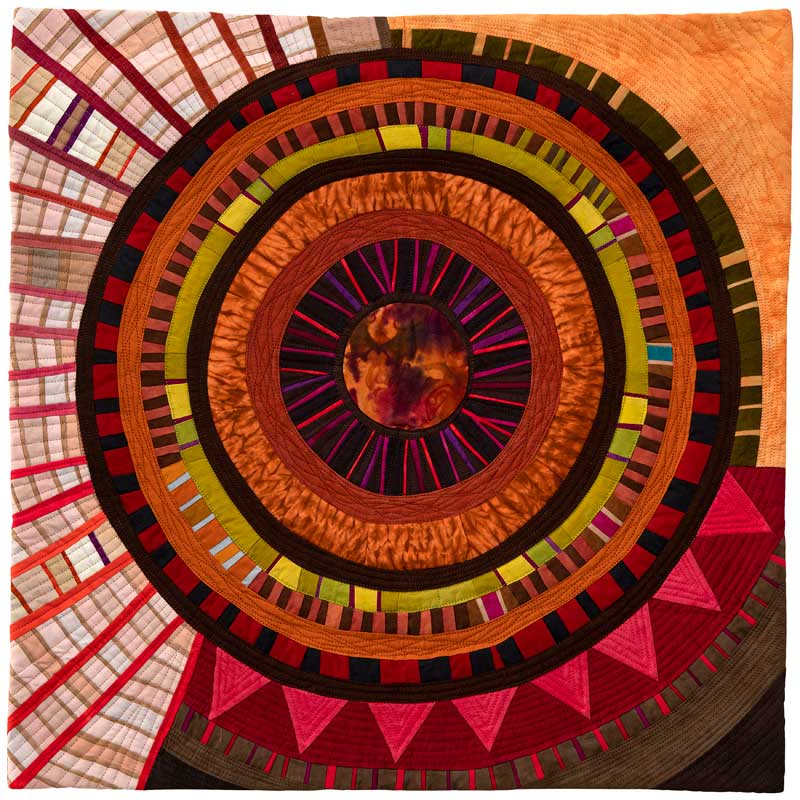

Statement: Visionary Dream — the future unknown, grasping. In this moment I see.
This piece was made from the centre eye outwards, working in concentric circles. Whether it is planetary, personal, or political, clarity of vision radiates into the future.
Techniques: Machine piecing. Machine quilting.
Materials: Shibori and low-water immersion dyed cotton fabric.
VISIONARY DREAM
©2020 Niraja Lorenz
Eugene, Oregon, USA
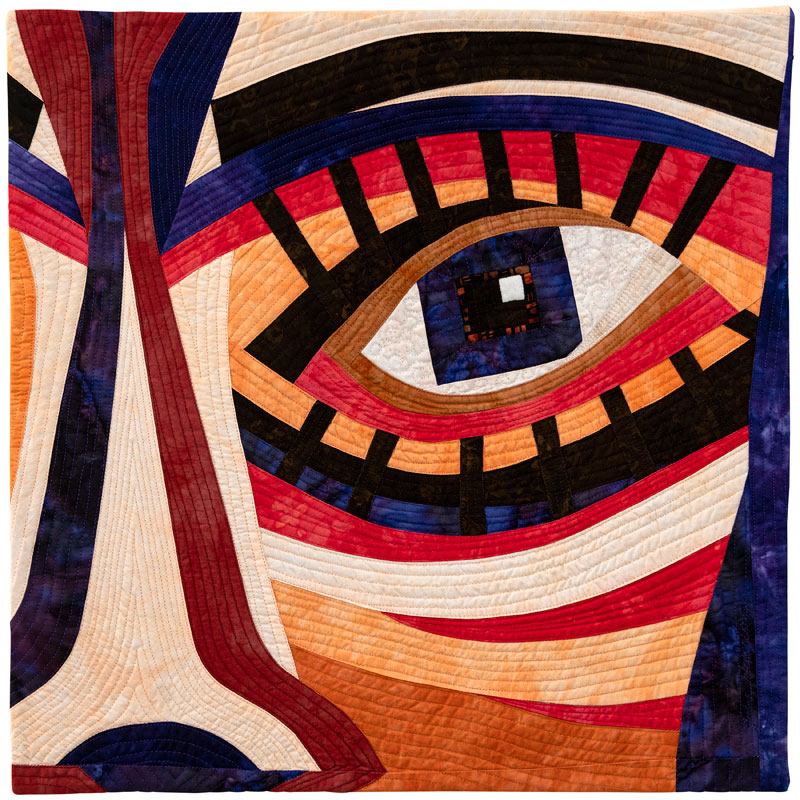
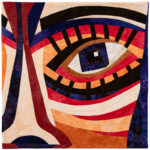
Statement: In my childhood years, I was told to go outside and play as watching too much television will give you square eyes. Today, with advances in technology, looking at a screen has become much more common. The reliance and influence of these technologies on vision, as well as physical and mental health has become a major concern.
Techniques: Improvisational curved piecing and free motion machine quilting.
Materials: Cotton and threads.
LOOKING FORWARD
©2020 Julie Harding
Toormina, NSW, Australia
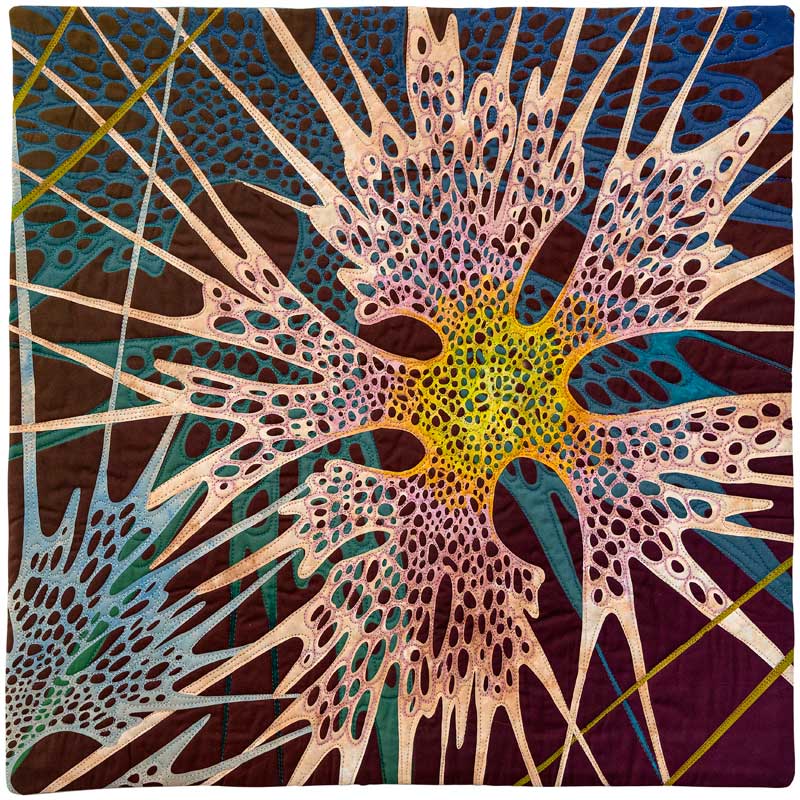
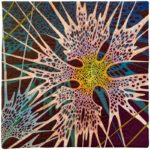
Statement: I am fascinated by the fact that the more you look into the macro world, the more you can see. Layer after layer reveals itself as we probe deeper into the unknown.
Techniques: Digital printing, machine cutting, heat appliqué and machine stitching.
Materials: Cotton and non-woven materials.
SIGHTLINES
©2020 Betty Busby
Albuquerque, New Mexico, USA
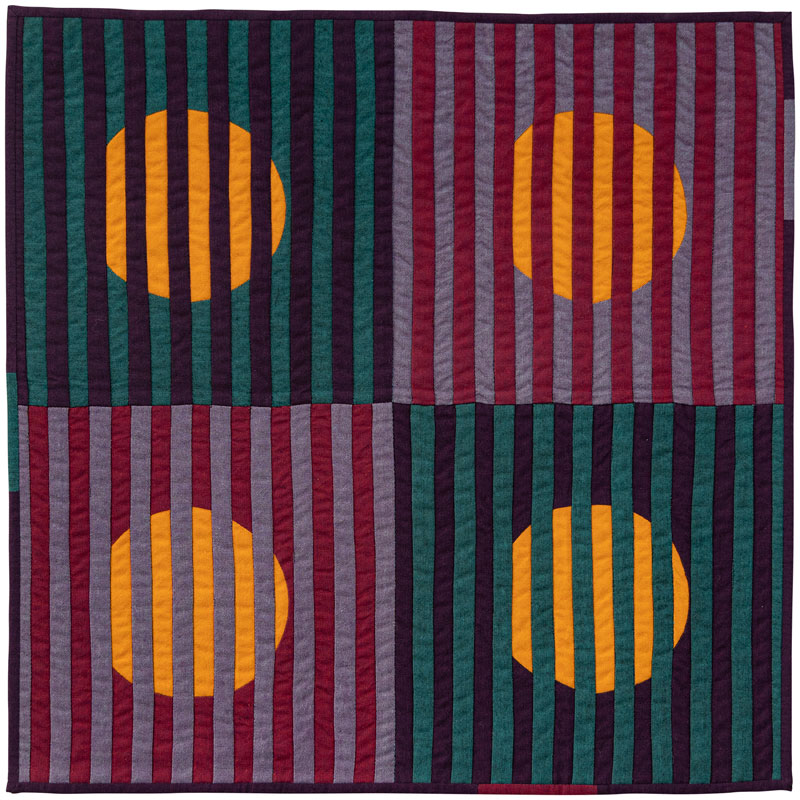
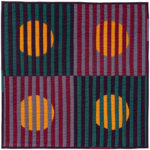
Statement: I was surprised to learn that the Munker White Illusion, a well known optical phenomena, is still not fully understood and there are a number of theories to explain the eye versus brain interaction. It could be more effective in fabric ... next time!
Techniques: Machine piecing and quilting.
Materials: Cotton, batting and thread.
PERCEPTION
©2020 Candice Walker
Glandore, South Australia, Australia
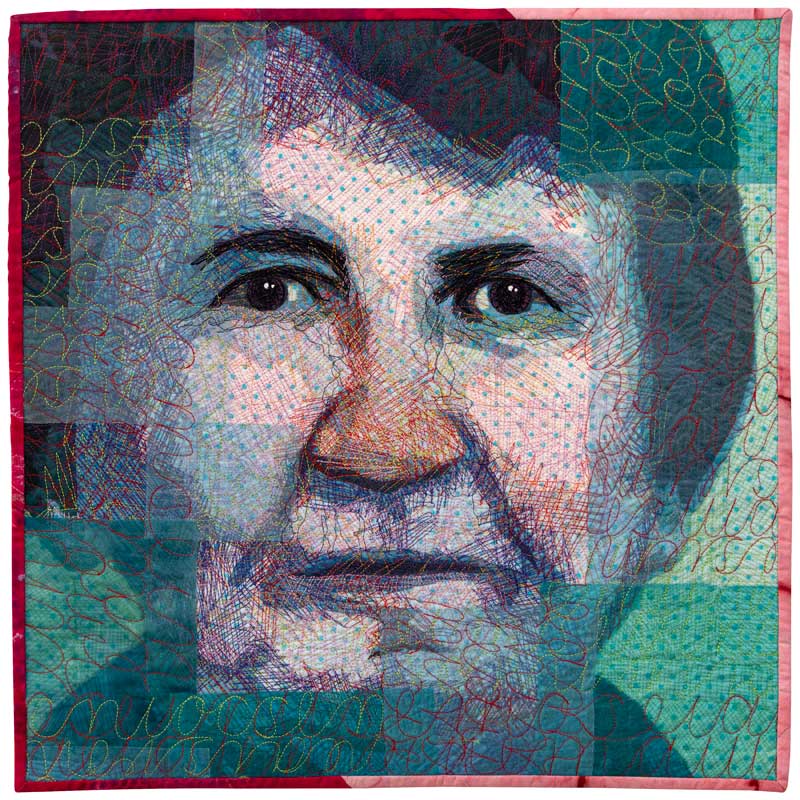
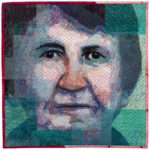
Statement: Age may have detrimental effects on physical sight, but will often bring the ability to "see" with the benefit of wisdom and the power of hindsight.
Techniques: Raw-edge appliqué, thread painting, free-motion quilting.
Materials: Cotton substrate, vintage and dyed sheers, polyester and cotton threads.
HINDSIGHT
©2020 Linden Lancaster
Picola, Victoria, Australia
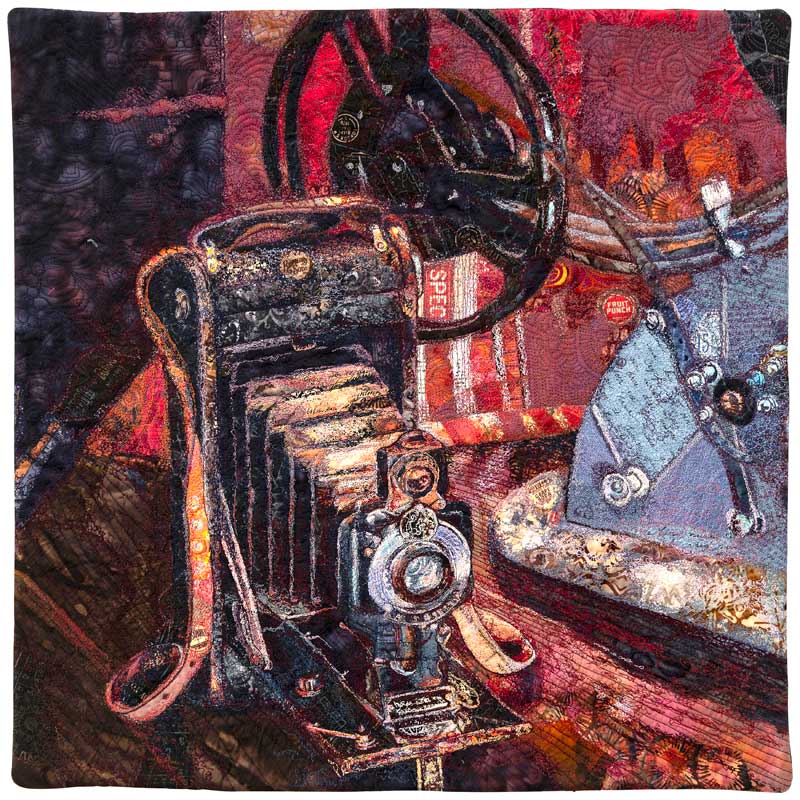
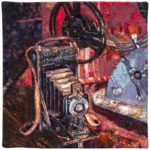
Statement: A picture says a thousand words, to see a realistic image without being there. This is a homage to the camera and projector. Thanks to those who had the vision, we can record what we see through a press of button.
Techniques: Fabric collage, thread painting and free motion quilting.
Materials: Commercial and hand-dyed cotton fabric, cotton threads, and wool/poly batting.
FORESIGHT TO CAPTURE
©2020 Sue de Vanny
Greenvale, Victoria, Australia
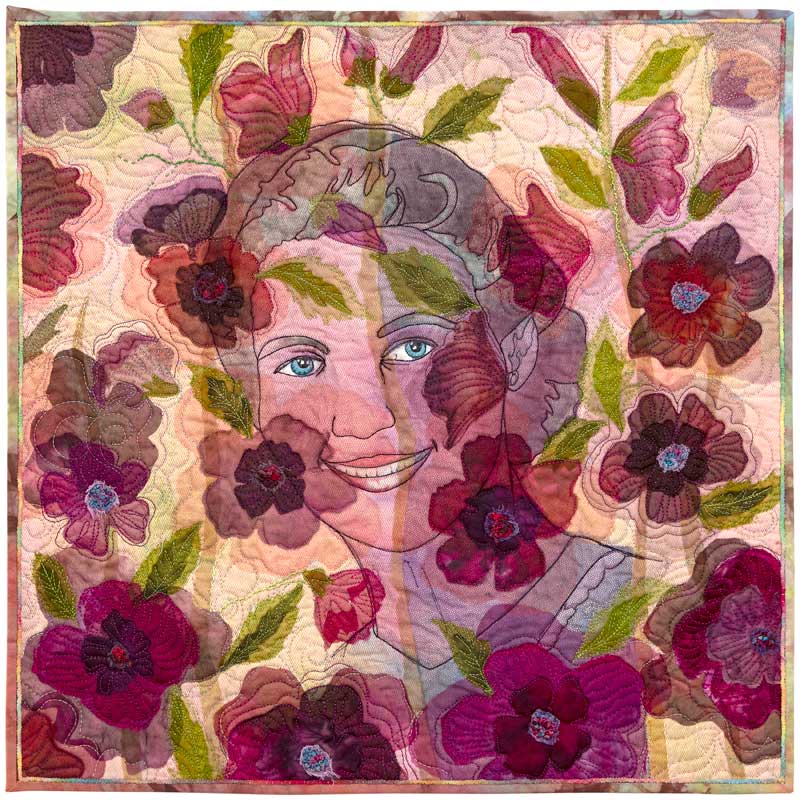

Statement: Portrait of my mother Betty, aged 20. Mum always looked to the future. In her later years, she became blind and deaf. Her loss of vision was a cruel blow, as she could no longer create her lovely appliqué quilts, except in her imagination.
Techniques: Painted portrait, quilted and overlaid with sheer fabrics. Embellished with hand stitching.
Materials: Hand dyed silk organza. Watercolour blocks. Cotton fabrics. Sheer fabrics, tulle and organza.
SHEER VISION
©2020 Mary Transom
Ohope, New Zealand
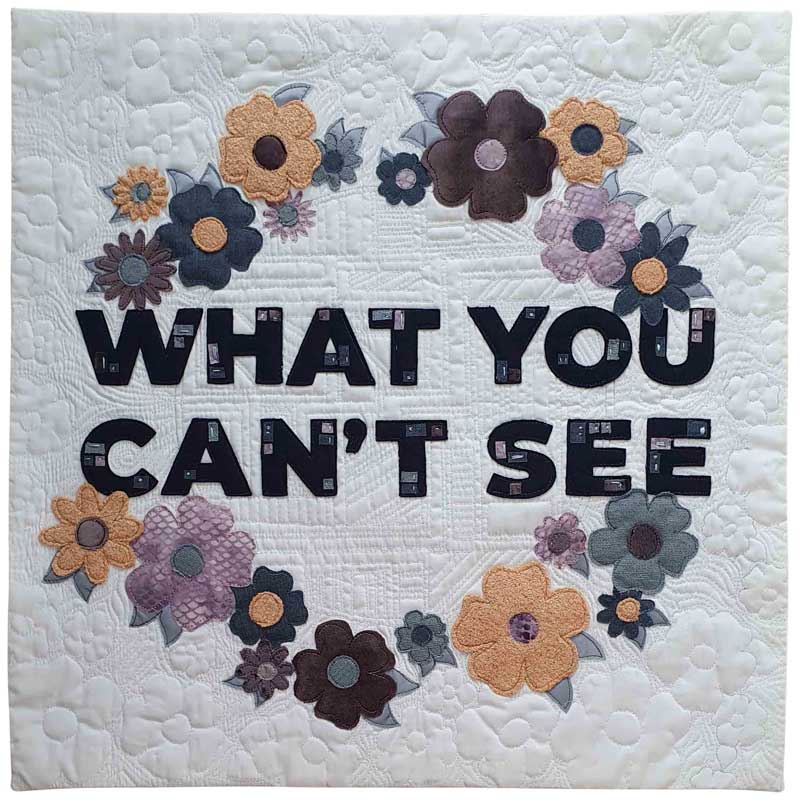
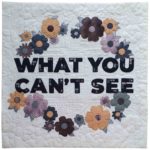
Statement: It's easy to have a vision when you follow in the footsteps of a someone you admire. However, for women entering male dominated fields, there is often no obvious precedent to follow. Instead, they must forge their own path and "be what they can't see".
Techniques: Digital design, raw edge appliqué, free motion quilting, hand embroidery.
Materials: Cotton, wool, silk and linen.
BE WHAT YOU CAN"T SEE
©2020 Lucy Sattler
Redlynch, Queensland, Australia
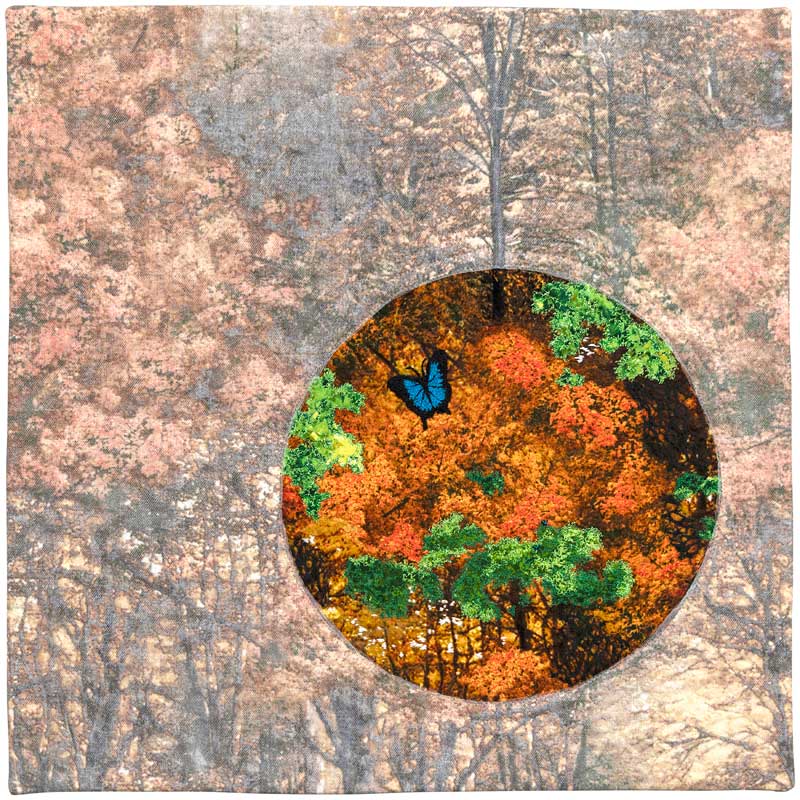
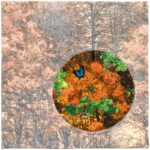
Statement: Many people have described the immediate vision changes after cataract surgery, the abounding brilliance of colour, especially as they view nature through different eyes. The haze is gone and even the detail of leaves is miraculous.
Techniques: Free motion machine and hand embroidery, fussy cutting and stenciling.
Materials: Lace, tulle, organza, cotton, and paint.
MIRACULOUS
©2020 Kay Haerland
Erina, NSW, Australia

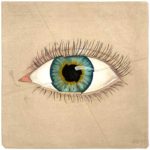
Statement: For the last year, my vision has shown signs of age-related decline. This is called presbyopia, a condition that affects almost everyone eventually.
Techniques: Painting, drawing, fusible raw edge construction, and embroidery.
Materials: Acrylic paint & medium, alcohol ink, pencil, various threads, linen/cotton fabric and fusible web.
FRAGMENT
©2020 Neroli Henderson
St Kilda, Victoria, Australia
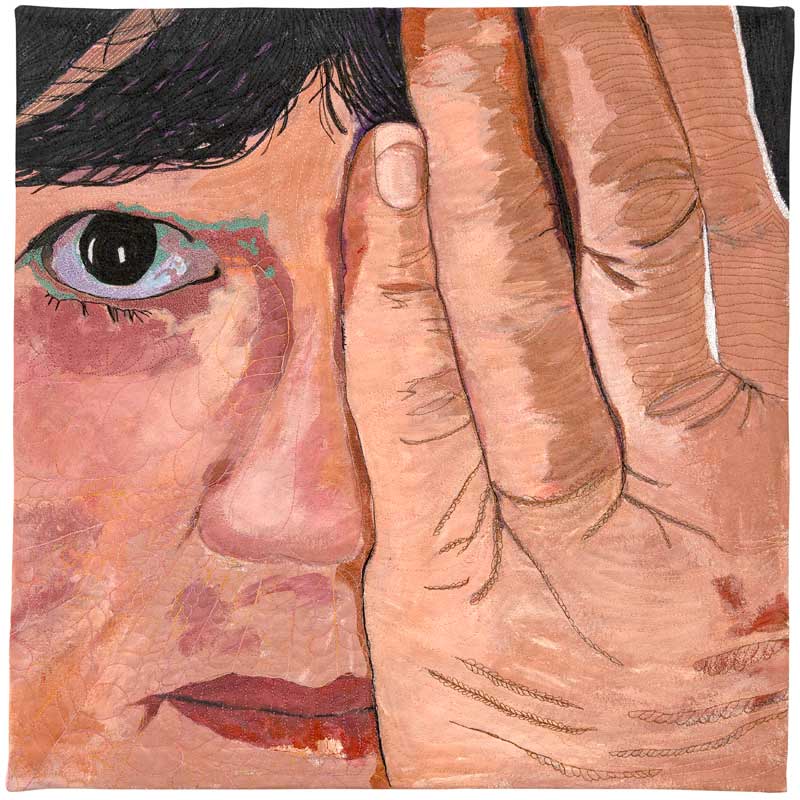
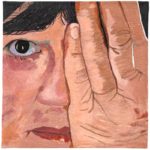
Statement: We are fortunate that we have access to free eye checks in Australia. Although we might have excellent vision, we still need to have the checks for other issues that may affect future sight. This is my reminder for regular eye checks.
Techniques: Wholecloth painting, layered and stitched.
Materials: Silk noil, cotton, textile paints and drawing ink.
VISION OK?
©2020 Christine Beardsley
Normanville, South Australia, Australia
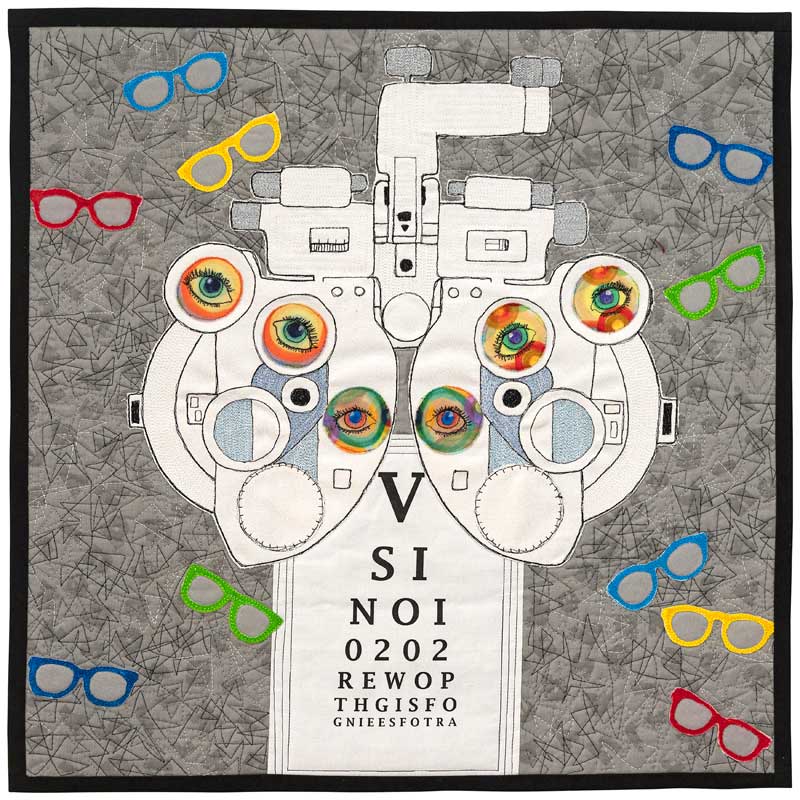
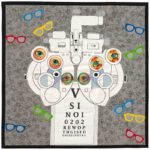
Statement: Do you have 20/20 vision? Can you read the 'Eye Chart'? Maybe not. Technology can be used to enhance our power of sight. Testing instruments and individually tailored prescription glasses enable those with impaired sight to achieve maximum vision.
Techniques: Raw edge appliqué and freeform machine embroidery.
Materials: Commercial cotton fabric, rayon thread, inkjet printed fabric and watercolour blocks.
MAXIMISING VISION
©2020 Sue Broadway
Ballarat, Victoria, Australia
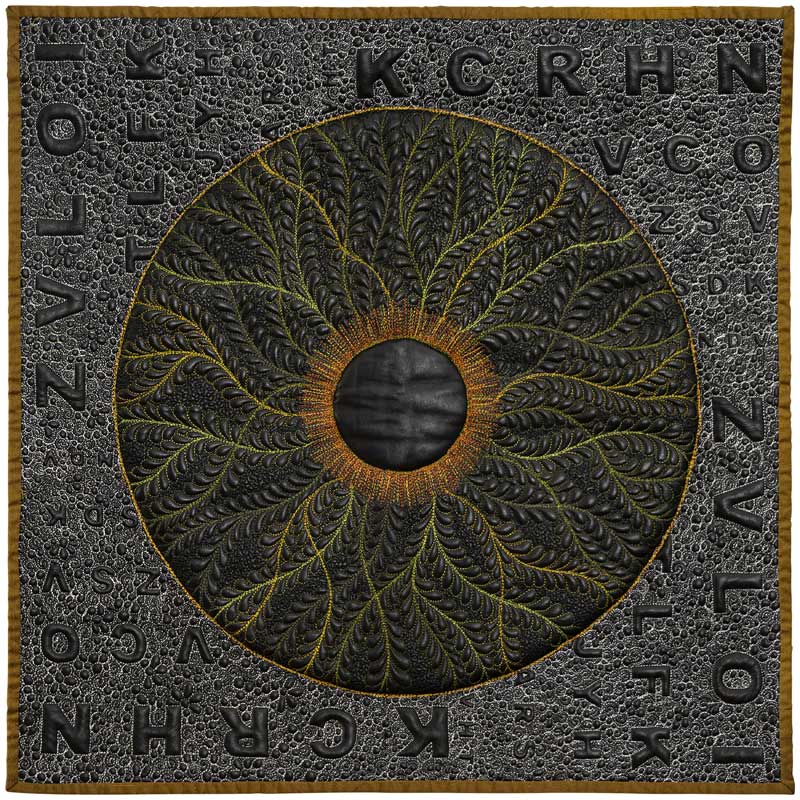
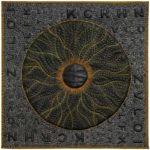
Statement: Only 5% of the world's population have hazel coloured eyes. This includes two of my children. No matter what colour your eyes are, it is vital to have them checked and tested regularly to reduce the risk of serious eye conditions and blindness.
Techniques: Leather wholecloth free motion quilted with layered trapunto.
Materials: Leather and silk quilted with rayon and polyester threads.
EYE SEE HAZEL
©2020 Rachelle Denneny
Glenelg North, South Australia, Australia
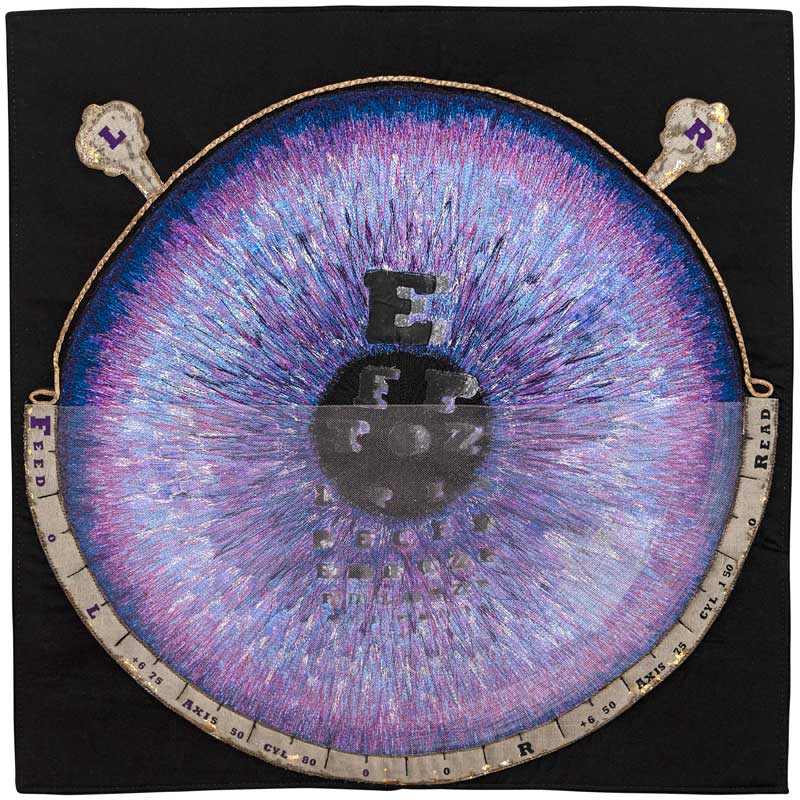
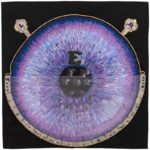
Statement: If only I had 20/20 vision! This piece is based on my eyesight, including my script, blurred vision (astigmatism) and eye charts that I could never read. Violet and blue are most vivid to me.
Techniques: Thread painting, printing, appliqué, and free motion quilting.
Materials: Cotton, thread, 100% silk, acrylic paint and tulle.
VIOLET IS BLUE
©2020 Rebecca Wolske
Boronia, Victoria, Australia
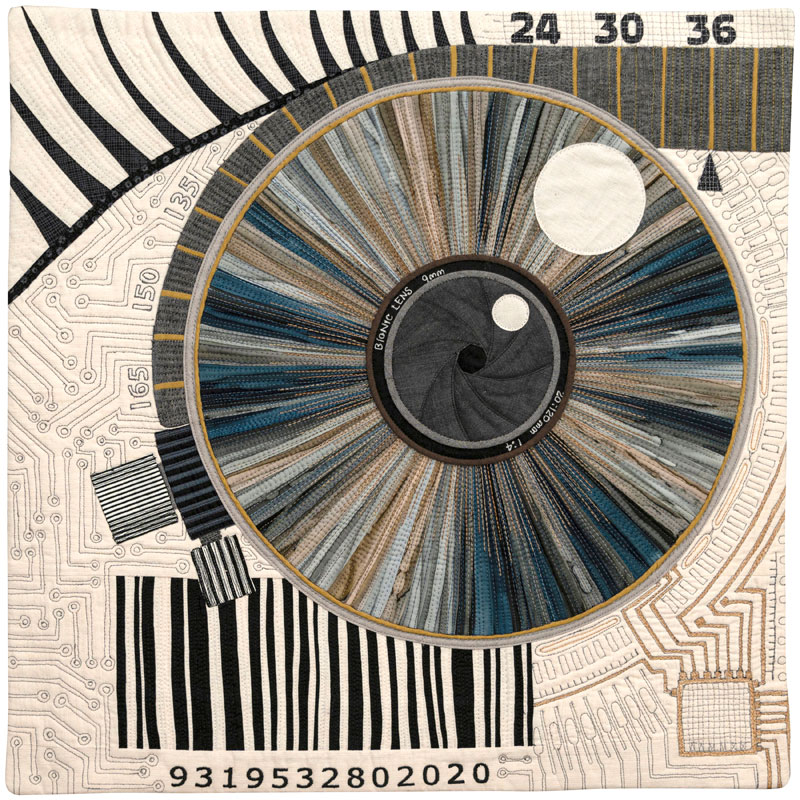
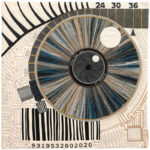
Statement: Reduced sight is a reality for half a million Australians. Development of a bionic eye is an exciting technology that may allow them to become more independent and return some quality of life.
Techniques: Piecing and appliqué, machine quilting and embroidery.
Materials: Cotton fabric and cotton/bamboo batting.
Bionic
©2020 Alison Withers
Warrnambool, Victoria, Australia
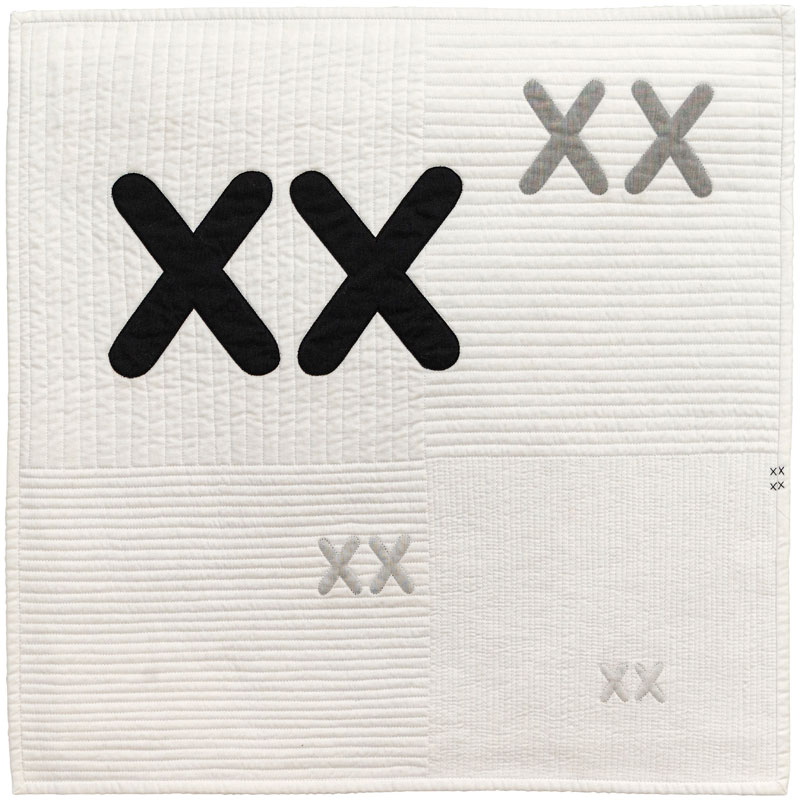
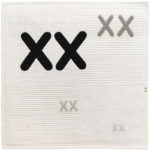
Statement: Traversing through life, one of our most treasured senses diminishes, eyesight. How I wish for my youthful vision. The one thing I strain to see is that small print at the bottom of the sight chart, depicted here on the right edge of the quilt.
Techniques: Shadow appliqué. Each XX is four layers of organza. Machine quilting and hand embroidery.
Materials: Cotton organza, perle thread and cotton batting.
SMALL PRINT
©2020 Wendy Nutt
Lemon Tree Passage, NSW, Australia
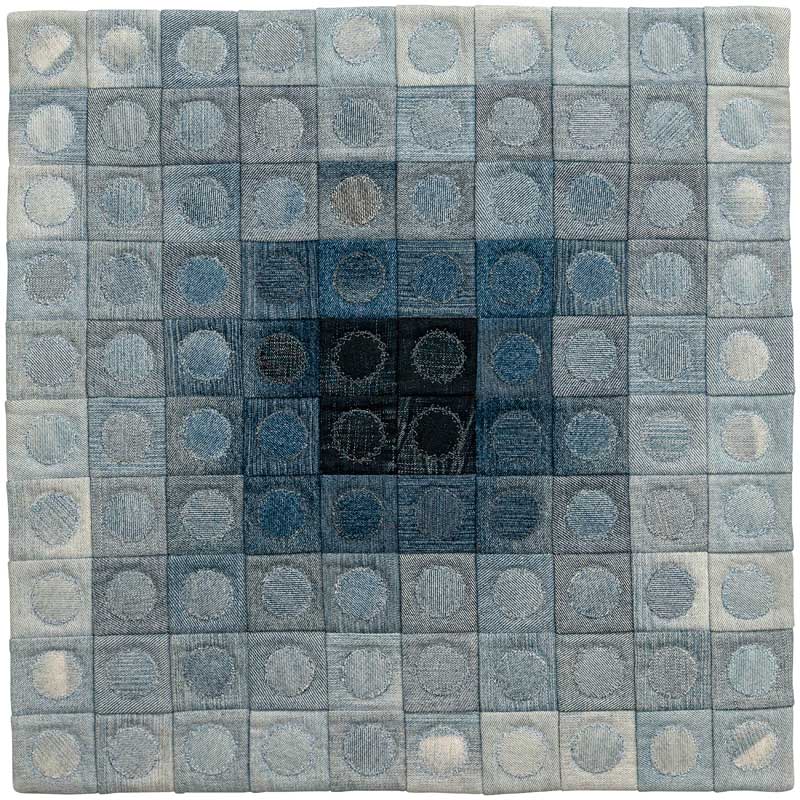
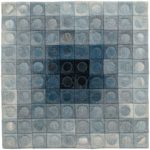
Statement: Following two cataract operations, a nuance or delicate variation in colour and tone was more readily perceived. Recycled denim marks the changes from almost white to a deep dark blue with the grain giving movement from circle to block.
Techniques: Machine pieced and quilted, fusible appliqué, manipulated machine embroidery stitch.
Materials: Recycled denim jeans.
NUANCE LIGHT
©2020 Beth & Trevor Reid
Canberra, ACT, Australia
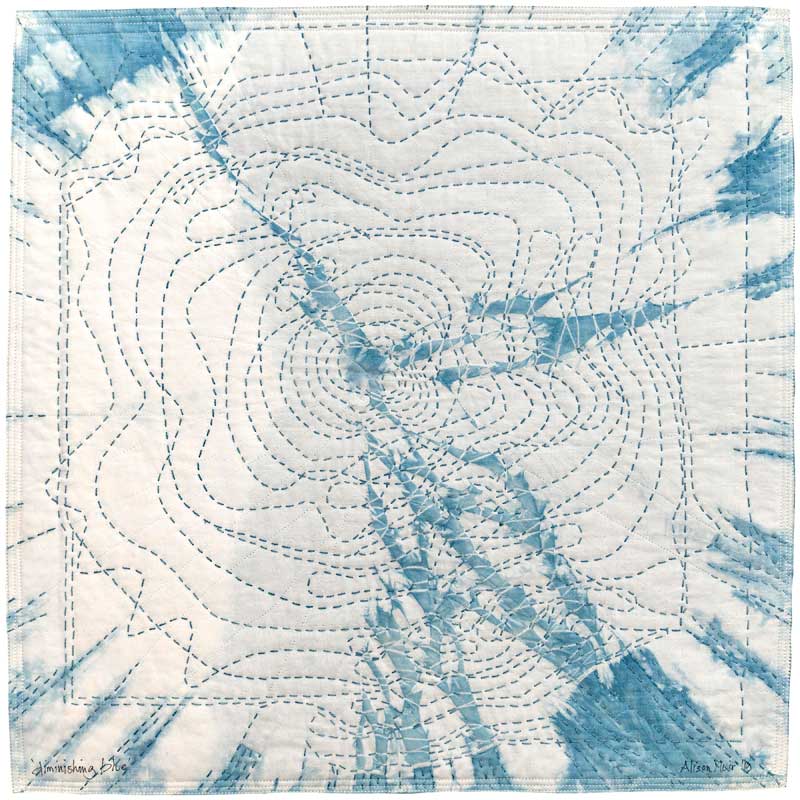
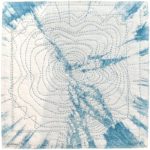
Statement: As we age, our ability to see blue diminishes.
Techniques: Arashi shibori, hand dyed, hand and machine stitching.
Materials: Cotton and indigo.
diminishing blue
©2020 Alison Muir
Cremorne, NSW, Australia

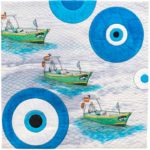
Statement: In an old tradition, Greek sailors paint eyes on their boats to safely guide their vessels and bring good luck. Another Greek superstition is of the “evil eye” but it is believed that wearing a blue and white talisman will shield one from danger.
Techniques: Hand dyed, hand drawn and painted. Machine quilting.
Materials: Cotton whole cloth, dye, textile ink, batting, and threads.
EVEN THE BOATS HAVE EYES IN GREECE
©2020 Sue Dennis
Brisbane, Queensland, Australia
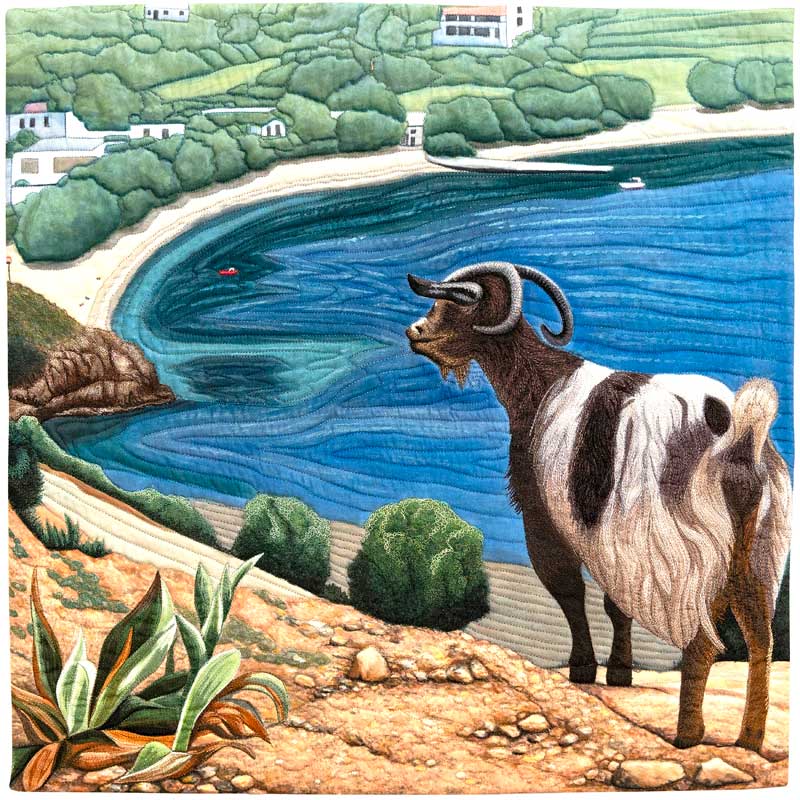
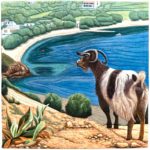
Statement: There are beautiful views all around the Greek Islands. I loved seeing this goat enjoying the view and was inspired to create this work.
Techniques: Whole cloth painting, thread painted in a hoop and free motion quilted.
Materials: Cotton fabric, fabric paint and various threads.
ENJOYING THE VIEW
©2020 Sonya Prchal
Whangarei, New Zealand
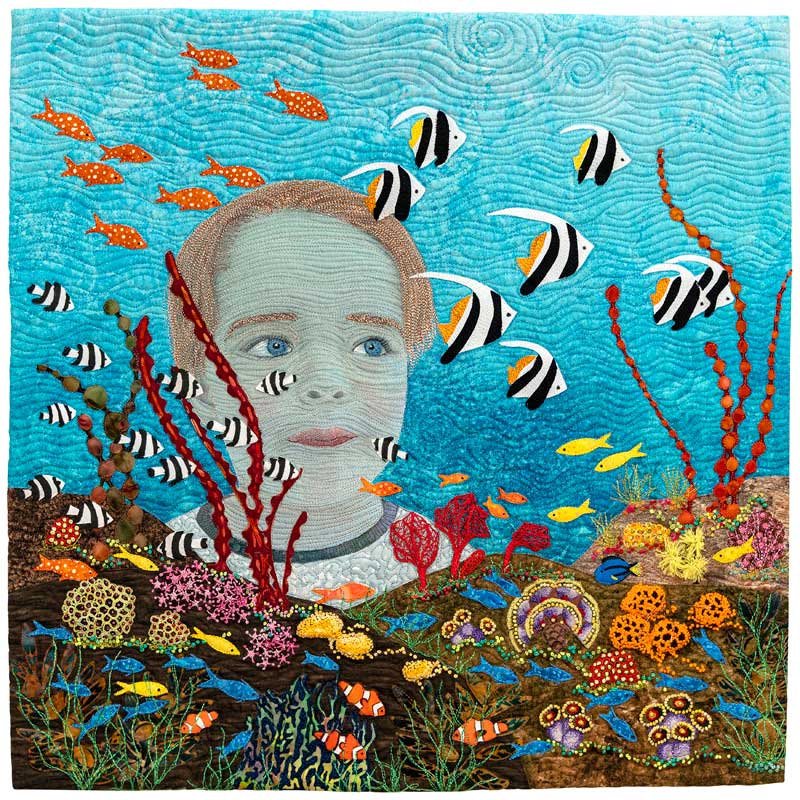

Statement: Many people are looking at the coral reefs around the world and wondering if they have a future. Will the future generations be able to enjoy the fragile beauty of the reef?
Techniques: Machine and hand embroidery, machine appliqué.
Materials: Cotton fabric, cotton, silk and rayon thread.
FRAGILE FUTURE
©2020 Linda Steele
Park Orchards, Victoria, Australia
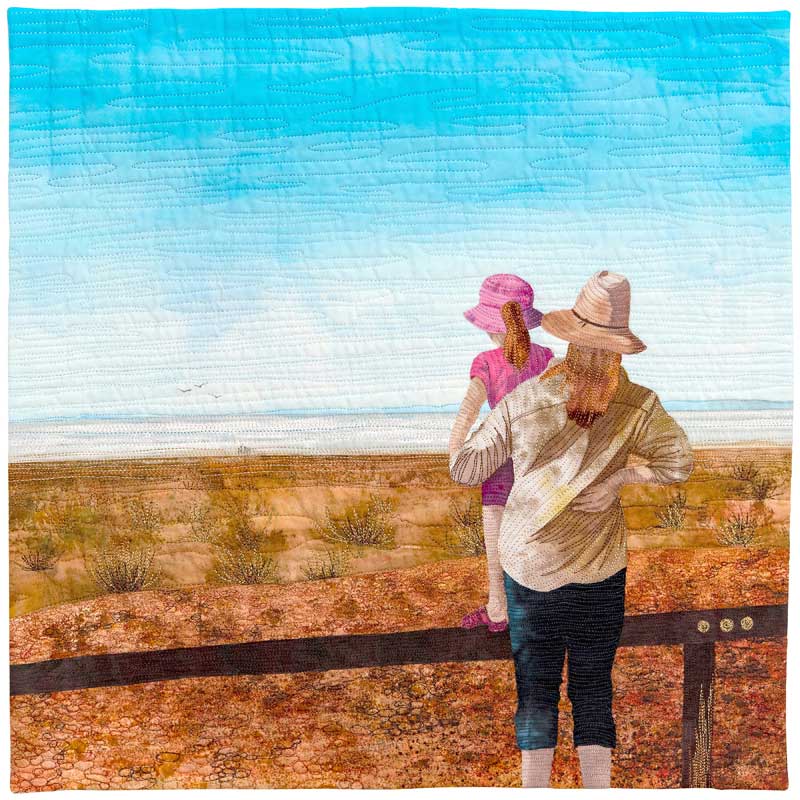
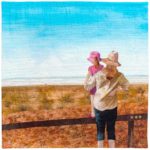
Statement: My son-in-law captured this image of my daughter and granddaughter on a trip to central Australia. I selected this image because of the distance/view of being able to see forever — well maybe nearly. It also shows the beauty of outback Australia.
Techniques: Hand painted and hand dyed fabrics, raw edge appliqué, free motion quilting and thread sketching.
Materials: Cotton fabrics, fabric paints, rayon and polyester threads.br/>
Copyright note: Based on a photo by Christopher Little (used with consent).
AS FAR AS THE EYE CAN SEE
©2020 Christine Dowell
Darling Heights, Queensland, Australia
Curator Statement:
From dreams to vistas, anatomical studies to optical illusions, Vision 2020 explores the theme of vision from different angles. Eye imagery dominates and many works highlight the importance of eye health and vision care. I embrace this focus. 90% of blindness or vision impairment is preventable or treatable. Prioritising eye health brings profound creative, social and economic benefits and 2020 brings extra resonance to this theme.
I look forward to exhibiting these fantastic artworks in the cloth at the earliest opportunity. In the meantime, enjoy this online gallery.
Brenda Gael Smith, Curator
© 2020 Vision 2020 Artists All Rights Reserved
